Painful economics for the Sounds





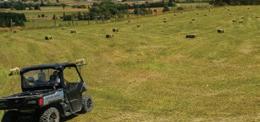

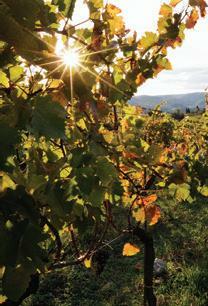


Stuck living and working from an of ficially closed road in Mahau Sound off the Kenepuru Road is a nightmare for everyone, says Robert and Sabine Harper who own Sherrington Honey. Marlborough Road’s announcement that where they live is a non-priority road and, with no clear plans for its reinstatement, the economic future is uncertain and options painful. The couple had 2000 beehives spread across the sounds until last year when they dropped back to 1300 due to the impact of the 2021 rain event. The August rain event is the second extreme rain in two years. Robert says they are feeding bees at this time of year and investing in the coming honey season but without road access he cannot successfully manage the



New and Used Tractors Top of the South from Karamea, Golden Bay, Murchison, Nelson Lakes, Blenheim, Nelson 32 King Edward St, Mouteka 03 528 9065 www.motfarm.co.nz ON farM SErvicE TEchNiciaN A NEW SEASON BEGINS WITH THE RIGHT TOOLS! Rugged frame construction Cutting elements supported top and bottom for added strength Quality hydraulic system with electric control PRE-PRUNERS TOBY raNDaLL 027 233 9170 toby.randall@harcourts.co.nz www.tobyrandall.co.nz Team Toby Randall Top of the South rural “New ideas, Old school values!” TRAILER HIRE MINI EXCAVATORS MINI TIPPER STUMP GRINDER LIGHT TOWERS 027 318 5885 | 26 LANSDOWNE RD, RICHMOND | LAMBECONSTRUCTION.CO.NZ LOCALLY OWNED AND OPERATED CIRCULATING TO 14,500 RURAL PROPERTIES IN MARLBOROUGH, TASMAN, NELSON AND WEST COAST NOVEMBER 2022 TOP SOUTH MONTHLY Farming Est 2001
Blenheim
PictonTapawera Murchison Reefton
Nelson Wakefield
Motueka
Takaka Collingwood Kaikoura Greymouth
Karamea
BARBARA STUART
Rob Harper of Sherrington Honey in the Marlborough Sounds.
Photo: Supplied.
SEE PAGE 3
Note from the editor
BARBARA STUART EDITOR

Heartfelt sympathy to everyone affected by flood and roading is sues after the August rain event, especially those in Marlbor ough.
Learning your road is ‘‘not a priority” and unable to eco nomically operate your farm or business is an overwhelming situation to be in when you are watching your assets de-value and your bank account go deep er into the red.

It’s a tough one to live through but somehow, we do.
I wish there was a miracle for everyone but the truth of it is, it will be a long-haul whatever decision Marlborough Roads
eventually reach.
When the 2011 event hit our road here at Cable Bay, near Nelson, with 35 big slips it took three years to sort it out. Around six months of access at specified times and another two years with traffic lights as crew fixed the slips one by one.
The roading gang gave the school bus a radio to let them know when it was coming through and slowly life returned to normal.
The benefit now of having engi neers in to manage how works are carried out were evident af ter the recent August rain event. Those slips on the bottom side of the road which were repaired with gabion baskets, held firm and this time, despite twice the
rainfall there is only two major slips to be repaired.
For all your sakes I hope the word “not a priority” simply mean a big wait and they will
eventually repair your road as funds become available. In the meantime, we hope you can call on loss of business insurance and somehow get by.

With the Queen Charlotte track and tourism cranking up again in the Sounds the economic benefit of a safe road must speak for itself.
Next year there is an election use the time to gain political and local government support wisely.
Now is the time to take care of yourselves. The Rural Support Trust wants to connect and sup port people living in isolation through times like this. Make getting out for a break a priority and above be kind to yourselves.
Alan Birchfield on coal
 BARBARA STUART
BARBARA STUART
Coal is a clean energy these days burned in modern fur naces its not the grubby ener gy it used to be. But these days we’re purchasing lots of it from Indonesia, says Alan Birchfield, Regional Councillor and West Coast Gold and coal miner.
Last year New Zealand import ed more than we had in 14 years, and this year we’re importing more to keep the economy working.
It appears, in spite of Green Party moves, the economy can’t work without massive amounts of coal, says Alan. Environ mental advocates say we’ve been resting on our clean, green lau rels for decades without do ing anything to increase our renewable energy generation.
“The electricity network is very





complex, and is finely balanced,” he says. “It takes a long time to make infrastructure changes, and societal, behavioural chang es. So, any reduction or shortterm reduction has a knock-on effect.”

Coal is making up the difference unless we want the nation to suffer power blackouts or com panies such as Fonterra stop exporting milk powder. Coal is also needed to fire up the aging and poorly maintained Huntly Power Station to keep the lights on in Auckland.
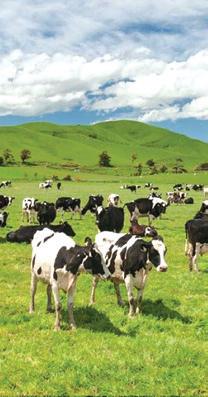
So where has the planning been? We have had a high level of re newable electricity. Between 80 and 90 percent since the 1970s. We’ve had big dams for a long time that have produced a lot of hydropower. We haven’t built any more dams, and we’ve had a huge population increase, add
to that, lifestyle changes where we are using more and more electricity. Supply hasn’t been able to keep up. The problem for environmental advocates is, yes, coal right now may be needed, and we admit that it’s still being
sold on the West Coast. So, coal is a necessary evil in this situa tion. But for environmental ad vocates this represents a massive failure in infrastructure plan ning by successive governments for the last 20 years.
There are still questions to be asked about the cost and quality of imported coal in comparison to locally produced high quality coal. New Zealand people of ten have simplistic high school level understanding of Climate Change and the actual effects of proposed mitigation which may not actually produce more cli mate friendly outcomes. When it comes to cost of importation, supply chain issues, loss of jobs and the long-term planning re quired to get the outcomes we all want. Serious debate and clarity from grass roots people is still needed.
†We service most makes and models. ^At participating retailers. *Offers valid from 01 September - 05 December 2022 on selected products or while stocks last. Terms and conditions apply. HELPFUL ADVICE COURTESY TOOLS AVAILABLE SERVICING SHOP ONLINE 24/7 NZ OWNED AND OPERATED 01 -2022 Ga oG P SPRING IS PRICE TRIMMER SEASON AT STIHL SHOP GET GST OFF * A WIDE RANGE OF TOOLS PLUS OTHER GREAT DEALS Live Local. Shop Local. Love Local! Does your vehicle need some attention? We’ll make sure you’re good to go! Your friendly local for all your automotive needs including: • WOF’s (Cars, Caravans, Motorbikes, Trailers & Tractors) • Wheel Alignments & Tyres • All Vehicle Servicing & Repairs • Petrol, Diesel & LPG P: (03) 541 8121 F: (03) 541 9325 67 Whitby Road, Wakefield E: admin@wasl.co.nz W: www.wasl.co.nz67 Whitby Road, Wakefield P: 541 8121 www.wasl.co.nz Full Service Blade Sharpen Spark Plugs 2 November 2022 News Farming TOP SOUTH MONTHLY Contact us 100% locally owned and operated 563 Main Road Stoke, Stoke, Nelson 03 548 5900 52 Scott Street, Blenheim 03 928 4121 Circulating to 14,500 rural properties in Nelson, Tasman, Marlborough and the West Coast every month. Farming TOP SOUTH MONTHLY News news@nmf.co.nz Advertising Sales Steve Page steve@nmf.co.nz Summa Donald summa@nmf.co.nz Raylene Wadsworth raylene@nmf.co.nz Accounts Queries accounts@topsouthmedia.co.nz Got something to buy, sell or promote? Contact us: sales@nmf.co.nz Farming TOP SOUTH MONTHLY
Alan Birchfield
Painful economics
water School students are affected.
hives. While boat and barge access are an option for some, where they live, and where the honey business is based, does not have deep water access complicat ing operations and access to all of his hive sites. The Harpers have also lost their worker due to the access is sues, adding to the strain of tending hives.
Sabine says there are around a thousand affected resi dents, many retired and about a third of the Link
Parents now have the di lemma of how to get their children to school regularly or home schooling as the school bus is no longer al lowed in to collect children.
Simple things like grocery shopping or medical ap pointments are difficult and there’s no longer rubbish removal skips, as emptying them is unsafe.

“We need to know what’s going to happen, when and how,” says Robert.
“It seems mad that so many
rate paying residents can’t have a road. When cy clone Bolar hit forty years
raft of personal, before a bulldozer can even make a start. This all costs an enor mous amount and progress is frustratingly slow.” Farming neighbours are equally worried.
ago, contractors came in and cleared the roads. These days it takes geo-tech engi neers, consents, and a whole

Barging in fertilizer or feed and getting stock to mar ket is logistically difficult and more expensive than by road with potential for health and safety issues for both humans and livestock. The future is worrying for most people as livelihoods are at risk without a reliable and safe road.
Additional M. Bovis infection inside controlled area notice boundary

An additional Mycoplas ma bovis property has been found inside the Wakanui area of Mid-Canterbury where strict biosecurity measures, including a con trolled area notice (CAN), were announced last week to eliminate a pocket of in fection in the area, says M. bovis Programme Director Simon Andrew.
“Today we can confirm that a property in the red area of the CAN is infected,” Mr An drew says. We are also un dertaking testing on another property in the area which is likely to be confirmed infect ed in the coming weeks.”
The CAN, which comes into force on 13 October, is a pre cautionary measure to re strict the movement of cattle in an effort to stop M. Bovis circulating in the area and


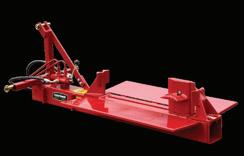

coincides with the planned depopulation of a nearby feedlot, which is an import ant next step toward eradi cation
“While the area is already under tight controls, and farms with known infection or suspected infection are under movement restriction, the CAN provides an extra layer of protection for farm ers outside of the boundary by restricting animal move ments out of the area,” he says.
“We are intensifying our ef forts to get to the tail end of the disease faster, which means farmers can expect to see more testing and more investigation into areas where there is residual risk, such as any possible trans mission routes.”
The background surveillance
that has been under way for some time now, with the na tional Bulk Tank Milk and Beef and Drystock Cattle surveillance programmes, will continue for the foresee able future and risk move ments will continue to be followed up.



This means farmers can expect to continue to see M. bovis Eradication Pro gramme staff on-farm and some farmers will be called to confirm whether they have cattle on their property for some time.
“Our bulk milk test pro gramme is going well, with no unexpected finds in re cent months. August 2022 is on track to be the first Au gust since 2018 with no con firmed infection detected via bulk tank milk surveillance.
“At this stage in the Pro

gramme, after everyone’s hard work and the 272 farm ers who have had to cull their cattle, we are intensi fying our efforts to find any possible infection,” Mr An drew says.
“It’s crucial we protect the investment made to date. We have four confirmed prop erties in Mid-Canterbury at present, the only area in the country with infection. This compares to about 40 na tionwide at the height of M. bovis.

“It’s also more important than ever that farmers con tinue to keep accurate NAIT records, as well as details of on-farm activity. Tracing animal movements remains our best tool to quickly track the movements of infected animals, or animals at risk of infection.”
Faults?
will fix it fast,

2021 2021 Date: 03/09/2020 No. of pages: 1 From: Kevin Quinn Phone: 022 639 2655 Size: 48mm x 86mm HILUX, HIACE AND EVERYTHING IN BETWEEN TOW BEHIND LOG SPLITTERS FREE DELIVERY to Nelson / Blenheim / Takaka / Westport / Greymouth Visit us at 109 Bolt Rd, Nelson 1.6m - 3.6m Optional Seed Spreader Top Quality PTO chippers Gravity or hydraulic roller feed 3.5”, 5”, 7” and 10” models CHIPPERS NEW PRODUCT 5 models available Made in NZ Powerful Kohler engines FROM $3,450+GST AERATORS www.dieselperformancesolutions.co.nzCONTACT US TODAY Richard 027 608 9394 Canterbury & Upper South Island Tractor Adblue
We
the first time TRACTORS • TRUCKS • HEADERS • UTES NewsFarming TOP SOUTH MONTHLY November 2022 3
FROM PAGE 1
“
This all costs an enormous amount and progress is frustratingly slow
RST Connecting with people living remotely during Adverse Events
The Top of the South Rural Support Trust say they want to connect and have good links into the Marlborough Sounds where farmers and growers live remotely.

When the August rain event hit Nelson, it also hit the area’s to the north of Nel son and the Marlborough Sounds areas of the South Island. Rai Valley, Kokorua Rd, Canvastown, the outer Marlborough Sounds and D’Urville Island were all hit hard. Many houses were un inhabitable in the short term and many roads severely damaged.
Residents living in some of the more remote areas lost direct connection to others close by and could be un aware of Civil Defence, and council support.
At the time a prolonged pe riod of cloudy weather im pacted on solar powered cell towers plus, after loss of elec tricity for several days’, landline batteries die. RST are
aware they need to identify key people within those rural communities and improve connection with them. They want to raise awareness that assistance can be available for them in times of emer gency and adverse events and is part of what the RST teams do.
When a weather bomb, fire or earthquake strike there can be structural damage to homes, water supplies, sew erage systems, other essen tial property infrastructure. There are personal health and medical needs on top of everything else involved with living in rural loca tions. The immediate needs can very quickly become overwhelming for those ad versely affected if they are on their own. The Rural Sup port Trust team is keen to let people know about the role they provide to get help and support to farmers and growers when catastroph ic events occur, especially if
the local resident population is swelled by holiday mak ers. At a regional level, West Coast, Golden Bay, Tasman, Nelson, and Marlborough RST’s are all directly linked into local Civil Defence, Council, Ministry Primary Industries, Rural Advisory Groups or Adverse Events groups, Primary Industry businesses, Rural Women, and Federated Farmers net works. RST personnel are made up of farming people who understand the needs of rural people. Watch out for them as they come to your communities and become part of the network.
After an event the RST pro vides needs-based support to help families, farmers grow ers and com-munities recov er and work across a broad range of agencies and groups to ensure we all become better prepared for the next event.
Contact Rural Support Trust today on 0800 787 254.
Reducing the impact of wildfire on your property
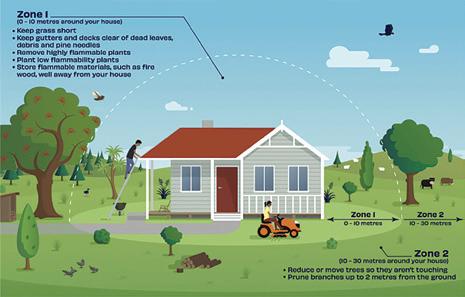 DARREN CRAWFORD
DARREN CRAWFORD
Landscaping with low flammabili ty plants can reduce the impact of wildfire around your home and other buildings.
It’s a perfect time of year to be planting so Fire and Emergency NZ encourage landscapers and gardeners to consid er the flammability of the plants they select.
Choosing less flammable plants can starve a wildfire of fuel reducing the fire intensity, and help protect your home and buildings from intense heat. Avoid using pea straw and bark mulch in gardens especially around the home and other buildings as these mulches are easily ignited and can help a wild fire to spread.
Low flammability plants aren’t fire proof but are less likely to catch fire. They generally have moist, supple leaves, low levels of sap or resin, and watery sap without much smell. They also have little dead wood or dead ma terial inside the plant.
A number of New Zealand’s native tree and shrub species have low or
low-moderate flammability and are therefore ideal for planting around your property. Very good information is available on our website: checkitsal right.nz
Fire and Emergency have Part nered with All Black legend Samu el Whitelock, who has a Bachelor of
Science, majoring in Plant Science, to help us spread the word about how planting low flammability palnts can help defend your home and proper ty from wildfire. Check out Samuel’s ‘plant barbeque’ at checkitsalright.nz As well as plant selection, these tips can really reduce your risk
FIRE SAFETY TIPS
• Create safety zones around your house to act as a barrier against fire.
• Plant low flammability plant species around buildings.
• Keep your lawn mown and well irrigated, your gutters and roof clear of debris, and choose low flammability plants.
• Make sure your driveway clearance is at least 4 metres wide and 4 metres high to allow access for emergency vehicles.
• Ensure there is easy access to water for firefighting.
• Check the wildfire risk regularly and think about when you do particular activities to reduce the risk of an accidental fire.
4 November 2022 News Farming TOP SOUTH MONTHLY
Rural Support and Agencies meet with Kenepuru Sound residents at Fish Bay.
Photo: Gavin O’Donnell.
Different safety zones of defensible space around a rural home. Image: Supplied.

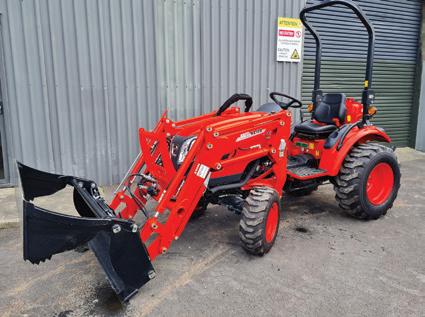
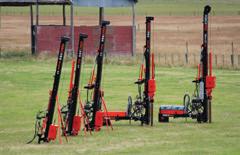






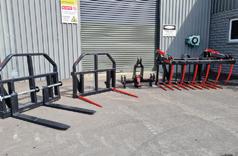


PH: 03 544 5723 Main Rd Appleby, Nelson 24 HOUR CALL OUT AVAILABLE Husqvana Ride On Mowers from $4,286 +GST Kioti CK3310 $31,980 +GST TRACTORS AND FARM MACHINERY Full service facility for all makes of tractor, baler, mower etc... Parts for all makes and models - All oils, lubricants, filters and wearing parts BMTT FINANCE AVAILABLE ON ALL NEW AND USED TRACTORS AND EQUIPMENT Krone Easy Cut R320 Mower $31,500 +GST JCB Digger 18Z $41,500 +GST Howards Slashers from $3,675 +GST Vicon PS403 Spreader $4,480 +GST Nelson Dealer for Sebco Fuel Tanks Fence Pro Post Drivers from $10,500 +GST Rata Implements from $1,730 +GST Sam Orchard Spreader $49,000 +GST Deutz Fahr Agrofarm 100 Rops with FEL $96,900 +GST AdvertFarming TOP SOUTH MONTHLY November 2022 5
Better for climate does not mean sacrificing quality

Animals bred for less impact on the climate are as healthy and produce meat quality just as good, if not better, newly pub lished results of long-running re search suggest.
New Zealand has been a world leader in the recent development of breeding sheep that belch out less methane – a relatively shortlived but potent greenhouse gas that contributes to climate change.
The progress stems from more than a decade of research by AgResearch scientists – sup ported by the industry through the Pastoral Greenhouse Gas Research Consortium (PGgRc) and Beef + Lamb New Zealand Genetics, and the government via the New Zealand Agricultural Greenhouse Gas Research Centre (NZAGRC).
The research proves that some sheep naturally emit less methane as a product of their digestion, and that this trait can be bred for and passed down through gener ations.
After three generations of breed ing, the lowest emitting sheep in a research flock produced close to 13 per cent less methane than the highest emitters, per kilogram of feed eaten.
However, questions have re


mained about whether this low methane trait means sacrifices for the health or quality of the animals, including quality of the meat that is derived for export around the world.
AgResearch senior scientist Su zanne Rowe says research pro vides a valuable insight into what the implications for breeding for lower methane are.

“Once we knew we could breed for less methane, we set about determining what the impact on the animal might be from birth through to parenthood,” Dr Rowe says.
The work was carried out in flocks across New Zealand us ing thousands of measures over several years to demonstrate that low methane emissions can be in cluded into breeding goals with out sacrificing other key health and performance traits, she says.
“What we have found is that breeding for lower methane, and the physiological changes we see in these lower emitting animals, do not negatively affect meat quality or those things meat pro ducers are looking for in the ani mal carcass. The story has some complex biology behind it as we saw that low-emitting animals have different eating behaviours, tending to be grazers rather than
gorgers – eating more feed than their high-emitting counterparts, even though the high emitters had bigger stomachs. This ‘lit tle and often’ approach seems to favour laying down muscle in stead of fat under the skin, whilst keeping the healthy fats that pro vide flavour, so meat quality is retained along with the reduced emissions.”
“We think the low-emitting ani mals may in fact have even great er economic value through de creased fat and increased meat yields.”
This is critical, she says, because farmers need to know that if they are committing to breeding their animals for lower methane, that they are not going to go back wards in their productivity and
earnings.
This knowledge provides great er incentive to make changes on farms that contribute to New Zealand’s methane reduction goals, and to climate change globally.
Research relating to the health of the sheep also suggests that breeding for low methane is un likely to affect issues such as in ternal parasites (as demonstrated by faecal egg counts), the fertility of adult ewes and the survival of lamb litters.
When it comes to wool, low methane breeding was favourable to fleece weight, while it was also favourable to the weight achieved by the animal before slaughter and its body condition.
The science is now enabling sheep breeders in New Zealand to breed for this low methane trait. Similar research is also now underway in New Zealand to achieve some thing similar in cattle, building on what has been achieved in sheep.
More research in this area is needed, researchers say, but these just-published findings are im portant for the ongoing science effort, for sharing with the indus tries, and for decision-making around climate change mitiga tions.
6 November 2022 News Farming TOP SOUTH MONTHLY
Breeding sheep that belch less methane, Dr Suzanne Rowe. Photo: Supplied.
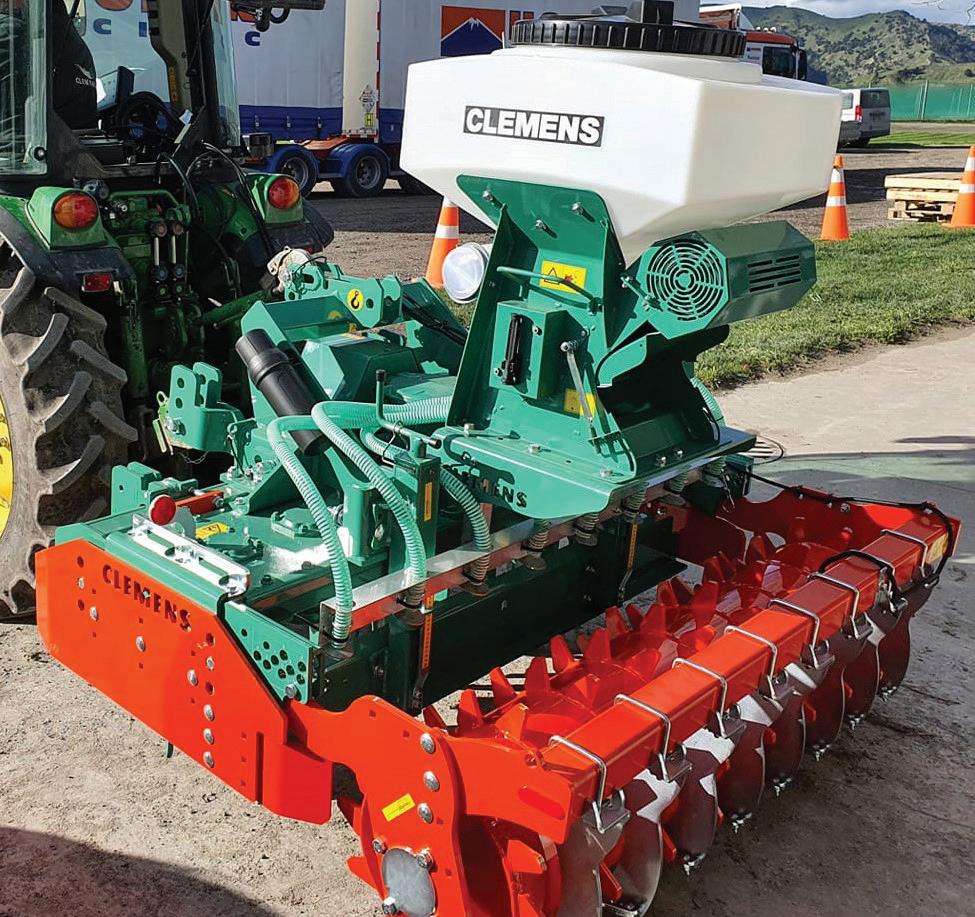


AdvertFarming TOP SOUTH MONTHLY November 2022 7
New project to help farmers gain regenerative agriculture certification
Interest in food produced using regenerative practices is gaining momentum across the globe –and the Ministry for Primary In dustries (MPI) is backing a proj ect to help more New Zealand sheep and beef farmers capture this premium market. MPI has committed $142,480 over two years through its Sus tainable Food and Fibre Futures fund towards the $356,200 project with Lean Meats Limited (trading as Atkins Ranch). It aims to scale up the number of verified lamb producers that meet the regener ative certification requirements of the US Savory Institute’s Land to Market Programme.
New Zealand-owned company Atkins Ranch has been a part ner of the Land to Market Pro gramme since 2019. It sells pre mium grass-fed lamb into the US market and has supply contracts across five regions of New Zea land. The company has been pi
loting regenerative farming prac tices since 2019 with a core group of 23 farmers, and this is now ex panding to more than 70 farms.
“I see regenerative agriculture as leaving the land in a better state for future generations,” says At kins Ranch chief executive officer Pat Maher.
“That includes improving soil health, minimising tillage, and encouraging biodiversity rather than monocultures.
“Land to Market is the world’s first verified outcomes-based regen erative certification. It requires partners to undertake a range of measures annually, which cover soil health, biodiversity, water in filtration, and ground cover.”
“Atkins Ranch was one of the first companies in the world to join the Savory programme. Part of the reason the programme piqued my interest is that I believe we al ready have a competitive advan tage over other countries due to
the way we farm in New Zealand. By showing that we meet interna tionally recognised regenerative agriculture standards we’re able to access high-value markets over seas.”
Lifelong farmer Stuart Ellingham was one of the first farmers to sign up to the pilot. He is managing di rector of Horizon Farming, which comprises eight farms on 10,000 hectares in Hawke’s Bay, and has a degree in agricultural commerce
from Lincoln University.

“I was sceptical at first,” says Mr Ellingham. “However, I saw it as an opportunity to put the micro scope on New Zealand to see how we stack up under the Savory In stitute’s measurement systems.
“With conventional farming practices in New Zealand I be lieve most farmers are under taking continuous improvement anyway. To meet Savory’s regen erative certification requirements

we just needed to tweak a few things, such as not undertaking full tillage cultivation, and being more aware of the soil.”
Steve Penno, MPI’s director of in vestment programmes, says this SFF Futures project is a good fit with the goals of the Government and food and fibre sector’s Fit for a Better World roadmap, which aims to improve productivity and reduce the impacts of food pro duction on our environment.
“Consumers are increasingly will ing to pay a premium for meat produced regeneratively and sus tainability is taking a front seat more and more in the way we produce food,” says Mr Penno.
“This project will help open up a new opportunity for more of our farmers to demonstrate the good work they’re doing – and with a few tweaks they can be rewarded for it.
For more information please email: media@mpi.govt.nz
Testing for Mycoplasma bovis stepped up with new strain
As announced, summer test ing for Mycoplasma bovis (M. bovis) will be stepped up after New Zealand’s nationwide sur veillance programme identified a new strain of the disease on one of the four confirmed positive properties, which are all in Mid Canterbury.
M. bovis programme director Si mon Andrew said recently com pleted genomic testing from a single property, which was pre viously confirmed with M.bovis, had identified the strain.
“This strain doesn’t behave any differently than the strain we have been dealing with, and our existing testing will pick it up, as
it has done in this case. It doesn’t affect our efforts to eradicate M. bovis from New Zealand.”
Mr Andrew said a thorough in vestigation was under way into historic pathways, which includ ed recorded and unrecorded an imal movements dating back to 2018, imported feed and farm machinery, and frozen semen im ported prior to the tightening of import health standards for bo vine germplasm.
“While considered a very low risk, frozen semen used on the af fected property, which had been imported prior to the introduc tion of the new import health standard, is being looked at.
“Our team is carrying out an in vestigation on the affected prop erty. At this stage, there is no ev idence to suggest that there has been any forward spread on any farms that received cattle from this farm.
“The bulk tank milk and beef herd screening (alongside our cattle tracing work) has not iden tified this strain anywhere else, but disease control is all about being cautious, so we will be in creasing the summer frequency of our national bulk milk surveil lance testing from once a month to every fortnight, as we do over spring.
“We have a national testing re
gime to find infection, which we didn’t when M. bovis was first found in 2017. M. bovis is cur rently on just four farms com pared to 40 at the height of the programme.
“It is important farmers know we are four years into a 10-year pro gramme, and we remain on track for eradication. We are moving towards a national pest manage ment plan for M. bovis much like that used for TB. The aim of that will be to monitor and deal with any disease that pops up over time.
“If our investigation into path ways reveals that further action is required, including targeted test
ing and surveillance on-farm, we will let farmers know, but at this stage the increased frequency of summer bulk tank milk testing, beef surveillance and tracing ani mals will serve us well.
“We thank farmers and our sec tor partners, Dairy NZ and Beef and Lamb New Zealand, for their continued vigilance as we work toward eradication,” Mr Andrew says.
“It was estimated that the cost of M.bovis to farmers would be $1.3 billion over 10 years, and much higher if it became endemic.”
Farmers with any concerns can call 0800 00 83 33 or email info@ mpi.govt.nz

Suppliers of all grades of industrial and household coal
• West Coast sub-bituminous coal with low ash, low sulphur and clean burning qualities
• High grade West Coast bituminous low ash coal

• Premium grades available for your boiler or multi fuel burner
• Bagged coal from 20kg to 1 tonne
• Bulk deliveries
• Coal storage in the Canterbury region for continuity of supply




Give Mark a call on 027 531 0998 for a competitive price to have your coal delivered direct from our mines to your place.
Phone 0800 110 602 Email mark@birchfieldcoal.co.nz www.birchfieldcoal.co.nz
8 November 2022 News Farming TOP SOUTH MONTHLY
New Zealand can access high-value markets by meeting regenerative certification requirements. Photo: Supplied.
VARIABLE




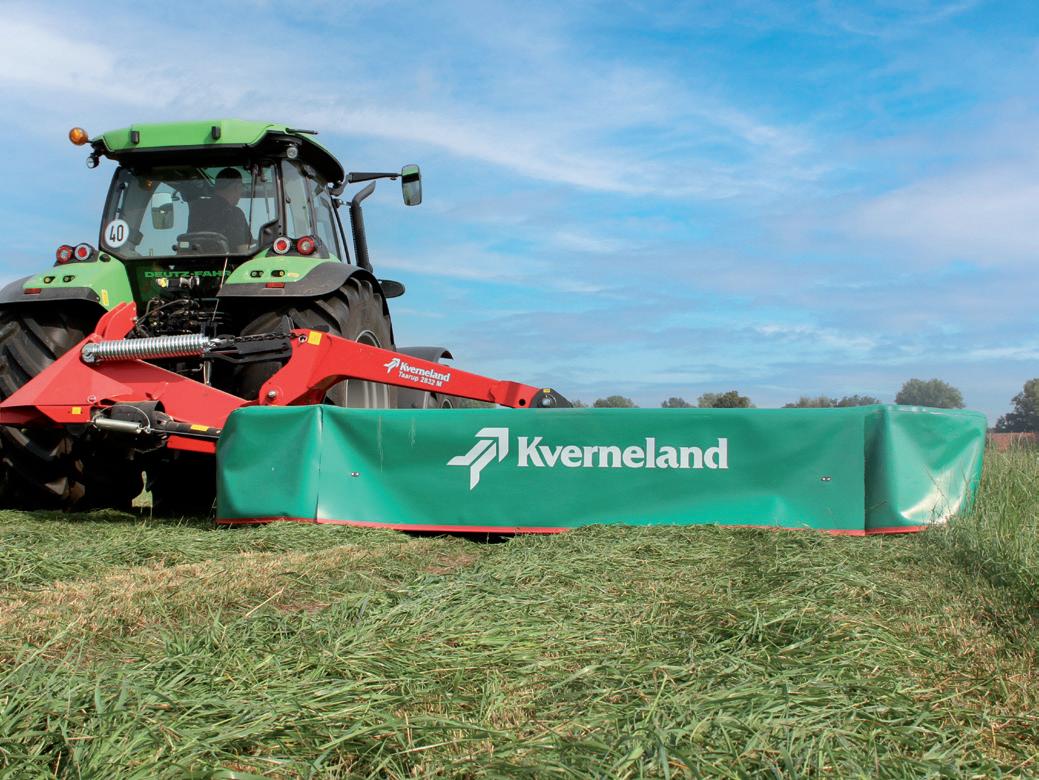
A BALE MADE BY PERFECTION V6750
CHAMBER The McHale V6750 variable chamber round baler has been designed with the demands of today’s farmer and contractor in mind. High-Intake 2.1m pick-up • 15 knife heavy-duty chopper unit & feed rotor Double drive system Auto Greasing • Net and bale density can be adjusted from the cab through the console The only mower with round discs. This gives better cutting and it leaves no pinch point for rocks to get caught. THE CUTTERBAR WITH ROUND DISCS The cutter-bar will swing backwards and up when hitting an obstacle and return to working position automatically (Instant reaction / non-stop). NON-STOP BREAK-BACK DEVICE The mower is lifted via the hydraulic cylinder – there is no need to activate the 3 point linkage of the tractor. EASY LIFT ON HEADLANDS The centre suspension provides an even weight distribution across the entire mowing width and a constant, faster and precise adaptation to ground contours. EVEN WEIGHT DISTRIBUTION FINANCE FROM 2.95%* FINANCE FROM 2.95%* Power Farming Marlborough Blenheim | 3535 SH 1, Riverlands | 03 573 7089 Trevor Youngman Sales 027 231 1186 Bryan Simpson Parts 027 362 1429 David Jeffery Sales 027 291 9576 Russell McGhie Service 027 365 1617 GET YOUR SEASON SORTED WITH THE KVERNELAND MOWER RANGE READY FOR GRASS? *Terms, conditions & normal lending criteria applies. While Stocks Last. AdvertFarming TOP SOUTH MONTHLY November 2022 9
DOVEDALE
Located in the desirable Win Valley and a real grass factory this 70ha (172 acres) property will appeal to astute buyers.



A meandering driveway leads to a stunning threebedroom, two-bathroom Adobe Brick homestead on an elevated site with ample garaging and storage. A designer kitchen and open-plan living are just some of the features of this impressive home. There is a full range of farm buildings and being well-tracked provides easy access to all areas of the farm. A very productive farm, ideal for dairy grazing, cattle finishing, or any class of livestock.
Inspection will not disappoint.
Income on Waimea West





How does the saying go, Location, Location, Location.. This property has it all - location, lifestyle, income and water. Just 5 km to Brightwater this lifestyle property offers purchasers a wide range of opportunities and multiple income streams. It provides the current vendors with a great passive income through rental units and leasing the land out.
and fertile Waimea silt loams mean anything will grow from fruit to vegetables. An irrigation consent allows 6.94ha to be irrigated. The main dwelling comprises three double bedrooms and two living areas and has two one-bedroom units attached. There is also a self-contained sleepout, a portable eco cottage and a second two-bedroom home all in their own private settings.
pggwre.co.nz/NEL36745
UPPER MOUTERE

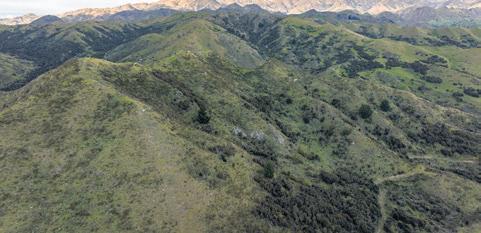
Quintessential Nelson rural living..
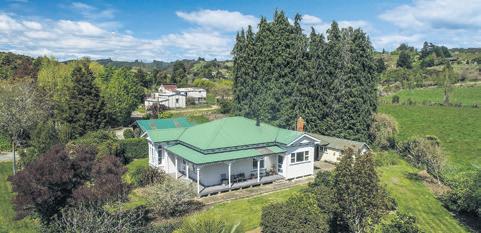


This lifestyle farm possesses a multitude of features that should tick the boxes on many fronts. Set on the quiet and peaceful Blackbird valley in the heart of Upper Moutere, approximately 6kms to Upper Moutere village. The 18-hectare property is subdivided into 10 paddocks with about half the contour in alluvial flats and the balance rolling to easy hill.A classic 4-bedroom villa has been tastefully modernised yet retains the charm of yesteryear. The home sits in established gardens affording privacy and all-day sun. The is a good range of support sheds with a 2-bay lockable garage by the house, a four bay implement shed, a large ex hop kiln and a 2 bay fruit storage shed.




PGG Wrightson Real Estate Limited, licensed under REAA 2008 Helping grow the country pggwre.co.nz/NEL36422
Appealing Small Farm
3 2 3 DEADLINE PRIVATE TREATY Plus GST (if any) (Unless Sold Prior) Closes 12.00pm, Friday 11 November 6 Gladstone Road, Nelson VIEW By Appointment Only E douglasjcsmith@pggwrightson.co.nz M 027 543 2280 Doug Smith E jblakiston@pggwrightson.co.nz M 027 434 4069 Joe Blakiston
NEW LISTING BRIGHTWATER
Flat
$2.3M Plus GST (if any) VIEW By Appointment Only E douglasjcsmith@pggwrightson.co.nz M 027 543 2280 Doug Smith pggwre.co.nz/NEL36798 NEW LISTING
ENQUIRIES OVER $1.7M Plus GST (if any) VIEW By Appointment Only E douglasjcsmith@pggwrightson.co.nz M 027 543 2280 Doug Smith pggwre.co.nz/BLE36744 AWATERE VALLEY Forestry Opportunity or Carbon Farming • 287 ha (subject to final survey) Good access to the property off Ballochdale Road, Awatere Valley Easy to moderate hill country Well tracked throughout giving good access • Fair percentage clean tussock country, balance scrub • Established forestry on one boundary Some of the property already approved by M.P.I for registration in the Emission Trading Scheme DEADLINE PRIVATE TREATY Plus GST (if any) (Unless Sold Prior) Closes 3.00pm, Tuesday 15 November 20 Westwood Ave, Blenheim VIEW By Appointment Only E kmcleod@pggwrightson.co.nz M 027 433 4746 Ken McLeod RURAL | LIFESTYLE | RESIDENTIAL 10 November 2022 Advert Farming TOP SOUTH MONTHLY
THORPE, TASMAN
Dovedale Dairy
Dovedale Dairy is a 161 Hectare mixed contour dairy farm incorporating two titles situated at 1517 Dovedale Road. The A2 dairy herd supplies Fonterra and a local liquid milk processor for premium returns. This contract is with the current owner and could possibly be transferred to a new owner if they met certain criteria. The hub of the operation is the 54 bale rotary cowshed along with the other farm improvements all in excellent condition and centrally placed for ease of operation. There is one house - a four bedroom open plan bungalow.
Ample water for irrigation is supplied by a 250 million litre storage dam with the 50ha of flats irrigated by K-Line. Domestic, stock and cowshed water is supplied by a well. The effective area of the farm is about 138ha and currently 350 cows are milked once a day.
Apart from the 50ha of the flats, 20ha is rolling with the balance in medium to steep hill. There is a 4ha block of native bush in QEII covenant and a 3.8ha block of trees.
This impressive property has the water to develop horticulture if a change in land use is desired and being only 40km to Richmond allows a new owner to experience the convenience and the best that the Nelson lifestyle has to offer.
For an Information Memorandum please contact Doug Viewing by Appointment only
$4.1M
VIEW
Doug Smith
M 027 543
E
Joe
M 027 434
E
CANVASTOWN
Premium Dairy Farm
Dalton Downs is widely regarded as one of Marlborough's premium dairy properties.
An opportunity presents itself to secure this 313ha (774 acres) topperforming dairy farm with a full range of high-quality dairy infrastructure.
Located in the heart of dairying in Marlborough, this dairy operation is nestled in a sheltered valley adjacent to the Pelorus River. The farm is predominantly




farming infrastructure and includes a 44 ASHB "De Laval" plant
30T silo plus a new
shed, four quality sheds (implement,




compliant effluent pond is
Boasting three dwellings including a modern 286sqm permanent material main homestead of five bedrooms and two

plus a double garage. Two further cottages
for staff on site.
with
slopes on the valley and consists of four titles.
The average production over the last three seasons is 290,000kg,
an
calf milk from a milking platform of 242ha. The property
area of 186
presents a
Dalton Downs is a farm of scale with a proven track record and represents a fantastic opportunity to produce a strong return, farm, and live in a friendly sunny rural community while enjoying all the recreational pursuits of the Marlborough sounds right on your doorstep.
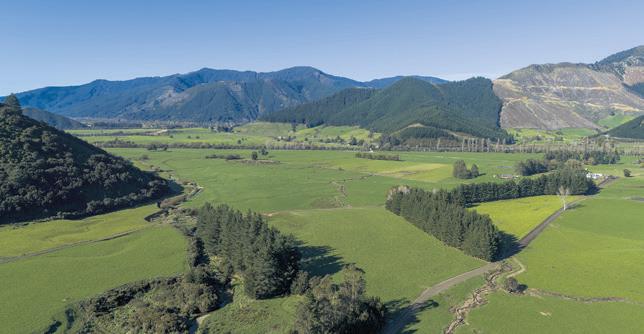
PGG Wrightson Real Estate Limited, licensed under REAA 2008 Helping grow the country pggwre.co.nz/NEL34789 EXCLUSIVE
Plus GST (if any)
By Appointment Only
jblakiston@pggwrightson.co.nz
4069
Blakiston
douglasjcsmith@pggwrightson.co.nz
2280
pggwre.co.nz/BLE36761
flat
gentle
including
has
irrigated
ha and
high standard of
milking
calf, hay sheds),
fully
operational.
bathrooms
offer comfortable living
5 2 2 DEADLINE PRIVATE TREATY Plus GST (if any) (Unless Sold Prior) Closes 1.00pm, Tuesday 22 November VIEW By Appointment Only E jblakiston@pggwrightson.co.nz M 027 434 4069 Joe Blakiston E greg.lyons@pggwrightson.co.nz M 027 579 1233 Greg Lyons RURAL | LIFESTYLE | RESIDENTIAL AdvertFarming TOP SOUTH MONTHLY November 2022 11
Passionate about sustainability


Tracey Marshall is passionate about her sustainability role at Pernod Ri card in Marlborough.

The company has an internation al profile for producing top quality beverages but for Tracey following through on the company’s sustainabil ity roadmap and 2030 goals is what makes her job meaningful.
Tracey was raised in northern South land and after gaining her degree at Lincoln University, began her career in the meat industry, where she was involved in food safety and environ mental compliance.
Eventually she shifted to Marlbor ough with her husband where they were both made redundant when the freezing works closed.
At that time, she entered the Wine In dustry as land-use changed from live stock farming to grapes. A change she has not regretted as she says the wine industry is supportive and an exciting place to work with great collaboration within the industry.
Tracey says the Pernod Ricard Sus tainability and Responsibility Road map 2030 has driven a wide range of pathways for achieving enduring out comes.
An example is a trial vineyard where they are entering their third season implementing regenerative practices to encourage development of more resilience from pests and disease, with the goal being reducing inputs.
What this means is a focus on build ing the ecosystem and soils, protect ing biodiversity, protecting the wet lands and natural processes to reach good outcomes for the environment plus encouraging other vineyard own ers to adopt these practices.
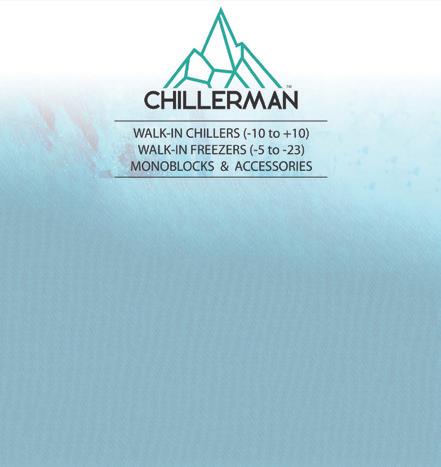
A successful partnership Pernod Ri card Winemakers has been involved in for many years is with the Marl borough Falcon Conservation Trust, including hosting the aviary on the vineyard.
Another growth focus is technolo gy where they have partnered with a Smart Machine a company develop ing and trialling autonomous robotic
tractors in the vineyards at Pernod Ricard Winemakers. Beyond this, they are using smart technology for preci sion irrigation, and sensors for an array of viticultural data. Machine company to develop autonomous robotic tractors.
In the vineyard, Pernod Ri card Winemakers are using smart technology for preci
Tracey says, as the wine in dustry booms and humans are needed for winery manage ment roles, a trio of inventors have created robotic vehicles to do labour-intensive tasks in vineyards – and the vehi cles are made entirely in New Zealand.


She says climate change and the need for reduced emis sions is a huge priority for Pernod Ricard Winemakers operations and why all their sustainable practices and the sharing of these stories is im portant. Particularly, she says, for their community and cus tomers to understand how the premium wines they enjoy, are grown.

12 November 2022 News Farming TOP SOUTH MONTHLY
BARBARA STUART
Smart Machine’s robotic vehicles, dubbed ‘Oxins’, will be capable of mulching, herbicide spraying, mowing, canopy trimming and spraying and leaf defoliating around the clock, in all seasons.” Photo: Supplied.
sion irrigation, and sensors for an array of viticultural data.
Tracey Marshall, Pernod Ricard Sustainability her passion. Photo: Jim Tannock Photography.
Meat the need NZ
Golden Bay farmer Wayne Langford has a high profile as the Yolo farmer but scratch the surface and there is a far great er purpose than meets the eye. Wayne and Tyler Langford’s real missions is meeting the need of Kiwi’s who are strug gling to feed themselves. Since beginning in early 2020, Meat the Need has provided 1 MILLION mince meals to families in need across NZ. They also supply foodbanks in Blenheim, Picton, Nelson, Motueka, Takaka, Westport, Greymouth and Hokitika.


Meat the Need is a charitable supply chain that allows Kiwi farmers to donate some of the food they produce, they work with Key partners like Silver Fern Farms and a whole list of other partners to deliver it to food banks across New Zea land.

One of those partners, David Green, of PGG Wrightson seeds says, “the concept reso nated with the values of their business.” It’s heartening he says, to see an initiative like this coming out of the grass roots farming sector. For PGG to play a small part in helping to make this hap
pen is important especially with the cost-of-living crisis hitting right now.
It’s fantastic to see Meat the Need reach a lofty goal of one million meals donated.
Asked what it was like to ap pear on TV3 with Sir Michael Jones and Sir Peter Leitch, Wayne says it was “pretty awe some.

Those guys are great role models and have done heaps for kiwis. Behind the scenes it was great to have time to chat about looking at further op portunities to work together.”
Anyone wanting to donate, head to meattheneed.org
The sports fishing season is off to a cracking start
BAYLEE KERSTEN West Coast Fish and Game
Anglers are reporting a fantastic start to the 2022/23 sports fishing season since it kicked off on Satur day the 1st of October.
West Coast Fish & Game officer Baylee Kersten said, “the combina tion of great weather and the first two weeks of the season coinciding with school holidays has resulted in some busy waterways with plenty of families out fishing.”
“Anglers are reporting some fantas tic fishing, with impressive catch es coming from especially our lake fisheries. Due to the Coast experi encing above average spring tem peratures, fishing has been superb. The good news for those that hav en’t managed to get out yet, is that the fishing is only going to improve as things continue to warm up! Al though we do encourage anglers to grab their fishing licences soon to get the best value for money. By purchasing your licence at the start of the season, you get a full years’ worth of fishing.”
“In the Nelson Marlborough region, a similar run of fine weeks since the start of the new season has seen most







rivers in great condition, perfect for spotting fish. A recent drive through the Upper Wairau and Motueka Rivers saw plenty of anglers out and some great fish being caught.”
“On the West Coast, having so many great fisheries scattered across the region and handy to our towns, there is no need to be a “weekend warrior.” With a fishery never far away and easy access available, go ing for an after-work fish is a great way to wind down and to invest in your wellbeing.”
“Looking at NIWA’s seasonal climate outlook we are set to experience an other fantastic summer, and our view is that there is no better way to enjoy it than with a rod in hand!”
“Rangers carrying out compliance over the past weeks have enjoyed catching up with many enthusiastic anglers, ranging from local families to those who have traveled halfway across the world to make use of our amazing fisheries.”
“No compliance issues have been detected so far this season, which is typical as a vast majority of anglers are happy to purchase their fishing licence and contribute to the man agement and protection of our fish eries.”
• Based in the top of the South Island we are 100% locally owned and operated
• With Barbara Stuart, editor with extensive on the ground knowledge and a growing team of journalists and relevant editorial content to support her.
• Delivered free to 14,500 rural mailboxes every month, from Greymouth, Westport, Nelson / Tasman, Golden Bay, Marlborough, Marlborough Sounds and everywhere in between • 20+ years of speaking directly to a target market for customers and readers alike.

Farming TOP SOUTH MONTHLY SOUTH Farming NEW SEASON BEGINS WITH TOOLS! Ploughing Champs come to SeddonFarming NEW SEASON BEGINS WITHTHE RIGHTTOOLS!PRE-PRUNERS www.tobyrandall.co.nz Toby Randall “New vic TE interested entertained becoming Handling high pressure 100% locally owned and operated RAYLENE WADSWORTH raylene@waimeaweekly.co.nz Phone: 027 458 9115
NewsFarming TOP SOUTH MONTHLY November 2022 13
BARBARA STUART
Sir Michael Jones, Wayne Langford and Sir Peter Leitch interviewed by TV3. Photo: Supplied.
O’Connor: We want a fair system for farmers
DAMIEN O’CONNOR Biosecurity and Agriculture Minister

A couple of years ago when the Zero Carbon Act was put in place, the Government made a major commitment to our pri mary industries.
We agreed to not automatically put them into the ETS, along with the rest of the economy. Farm ers and growers said at the time there needed to be a better way for them to pull their weight in reducing greenhouse gases.
We agreed with you.
The hard work done by the He Waka Eke Noa partnership since then to put together their pro posed system has gone a long way to providing that solution.
We have accepted nearly all of their recommendations: a farm-level levy, methane and ni trous oxide as split gases, re-in vesting the levy into the sector, remaining out of the ETS, and recognising on-farm sequestra tion.
We found outstanding issues in only two aspects of the proposal – who will set the price for split gases, and how sequestration is accounted for and managed.
Like any levy system, price set ting needs independence - hence
Ministers taking on this respon sibility, based on advice from the Climate Change Commission.
On sequestration, both proposals recognise its complexity, and we too believe more work is needed on it.
To be clear, we’ve not ruled out recognising additional on-farm sequestration. I’m committed to doing more work so there’s a fair system for farmers to claim the important work they’re doing to reduce the impacts of greenhouse gases.
It just needs to be done in a way that is efficient, verifiable, and does not create an unworkable burden on farmers. Those are the challenges that I want to hear people’s thoughts about via the consultation that is happening. We want a system that has equity and fairness.

This is our goal. Like the Partner ship’s modelling before it, our re sponse shows the red meat sector will be affected more than others.
I do not however, believe for one second that is where things will end up.
That’s because alongside the sec tor the Government is investing hundreds of millions of dollars in climate research through a joint venture with key sector business es to deliver emissions reductions
tools into farmers’ hands sooner. Climate change isn’t coming… it is happening now.
For the past five years, MPI’s ad verse event fund has been blown out of the water by 900 per cent due to floods and drought. For instance, we practically had a na tionwide drought spanning 2019 to 2021 and we are also seeing
tropical storms sweeping further south.
Talk of emissions leakage – which is production falling in New Zea land and rising in another coun try – or risking food security are things I simply don’t subscribe to. The counter factual is this: doing nothing will create greater food insecurity and price volatility.
The macroeconomic factors are there.
The insurance and finance sys tems are already factoring in cli mate change.
The trade environment is already moving. Our customers overseas are moving.
I’ve steadily assessed the technol ogy coming on stream, the pos itivity with which exporters are approaching their markets, and the huge investment of $339 mil lion we’re making, which includes the 50:50 joint venture with busi ness that I referred to earlier. I am confident that our sector will beat others to reach our 10 per cent methane reduction target by 2030, not because of the pricing of gases, but because of the re ductions we will achieve through new technology and practices. Through this we will maintain our productivity and create value. Why do consumers overseas seek out New Zealand products? It’s because they have a perception that “if it comes from New Zea land, it must be good for you.” That is brand value.
In the future they will say “be cause it comes from New Zea land it must be good for me and the planet.”
We can do this by continuing to work together.
14 November 2022 News Farming TOP SOUTH MONTHLY
Biosecurity and Agriculture Minister Damien O’Connor. Photo: Supplied.
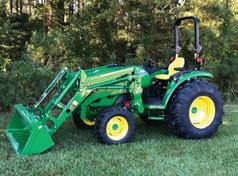









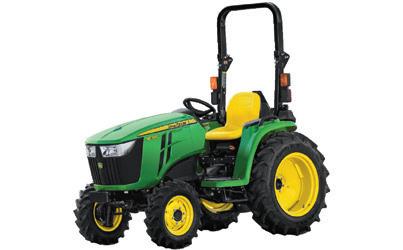



BIG IMPACT *Terms & conditions apply. Free BBQ available with orders placed between 1/11/22 and 31/1/23. ^Conditions apply. 6 year/2000 hours (whichever comes first). See your local branch for more information. John Deere 4044R TRACTOR AND LOADER PACKAGES AVAILABLE POWERTRAIN WARRANTY 6-YEAR John Deere 3038E POWERTRAIN WARRANTY 6-YEAR
John
Deere 2025R POWERTRAIN WARRANTY 6-YEAR
John
Deere 1023E POWERTRAIN WARRANTY 6-YEAR 0800 432 633 www.dne.co.nz SMALL TRACTORS FREE BBQ! Need a helping hand round the lifestyle block, or an efficient hard worker on the farm? Give us a call today! FREE Q2000 BARBECUE with every new John Deere compact tractor* AND FOR A LIMITED TIME GET A * AdvertFarming TOP SOUTH MONTHLY November 2022 15
Horticulture sector praises government moves

The horticulture sector is praising the government’s moves to introduce strict new regulations to protect highly pro ductive land used for growing vegetables and fruit.

HortNZ chair Barry O’Neil says the sec tor is pleased with the plans and it is something it had been advocating for some time. He believes the new regula tions will protect highly productive land for this and future generations.
During the past 20 years, about 35,000 hectares of highly productive land has been carved up for urban or rural resi
dential developent, while 170,000 hect ares has been converted to lifestyle blocks.
The new regulations are enshrined in a document called the National Policy Statement for Highly Productive Land (NPS-HPL). The objective is to enhance protection for NZ’s most productive land and providing security for both our do mestic food supply and primary exports.
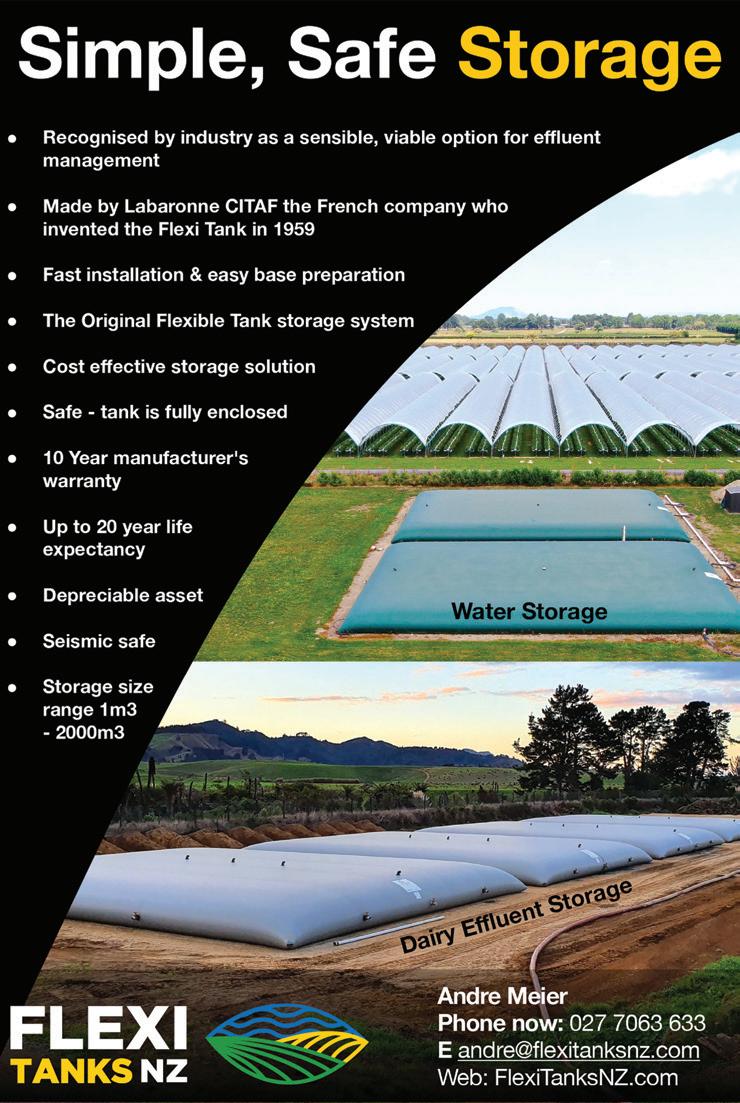
Environment Minister David Parker claims the NPS will greatly improve how NZ protects highly productive land from inappropriate subdivision, use and devel opment.
“We need to house our people and to feed them too. Our cities and towns need to grow but not at the expense of the land that’s best suited to grow our food,” he says. “This NPS will help protect our best growing areas so Kiwis will continue to have access to leafy greens and other healthy foods.”
Parker says councils will be required to identify, map and manage highly produc tive land to ensure it’s available for grow ing vegetables, fruit and other primary production, now and into the future.
Agriculture Minister Damien O’Connor
says once land is built on, it can no longer be used to grow food and fibre.
“That’s why we are moving to protect our most fertile and versatile land, especially in our main food production areas like Auckland, Waikato, Hawke’s Bay, Horowhenua and Can terbury.”
Not Too Late
Advocating for governments to act in regard to protecting highly productive soils has been going on for some time, O’Neil says it’s not too late and should result in protecting land in major fruit and vegetable growing areas.
Some local authorities have been strongly crit icised for not doing enough to stop productive land going into housing or lifestyle blocks.
O’Neil believes the NPS will clear up any doubts about what they have to do.
“I think local government has been reaching out for direction like this for some time so I believe they will welcome this,” he told Rural News.
While the new rules cover all highly produc tive land, O’Neil says protecting vegetable growing land is the absolute priority.
“If we can’t protect our vegetable growing locations we will end up importing frozen vegetables from countries offshore,” he says. “While more pressing in the vegetable space, it also impacts on fruit production as well.”
O’Neil points to the Heretaunga Plains in Hawke’s Bay where a significant amount of land has been lost from fruit production.
In Bay of Plenty areas such Omokoroa are now just about all housing - with the kiwifruit pro duction area moved to tar seal and concrete.
O’Neil adds it’s not only urban sprawl that has taken highly productive land-lifestyle blocks are also an issue. He says often the problem starts with lifestyle blocks which then pro gresses to high density housing.
16 November 2022 News Farming TOP SOUTH MONTHLY
National’s Maureen Pugh and Barbara Kuriger meet with farmers in Tapawera and Murchison
BARBARA STUART
National list MP Maureen Pugh and Barbara Kuriger met with communities at Tapawera and Murchison to hear concerns af fecting their communities.
The next day Barbara stepped aside due to a conflict of interest between her family and Ministry for Primary Industries.
Maureen said after the last elec tion National wants to rebuild trust with farmers and the rural sector.
Farming communities have had layer upon layer of regulation and cost place on them without the ability to recoup returns.
Government claims that compli ance will bring about premium returns are simply based on the ory and not tested in the interna tional market. She says National will want to see these claims test ed. She says it’s been difficult to influence policy decision at select committee level as the opposition has so many elected representa tives at the table.
Questioned on Nationals stance on the emissions target, Barbara said National would honour the agreement but the pathway to reaching targets would be differ ent.
“National’s approach would be led by proven science, options like breeding from bulls who produce less methane. Accepting farm shelter belts and investing in research and genetic editing to develop rye grass that reduces methane rather than see sheep

and beef farms unable to remain economic.”
She said there is a lot of work to be done to grow understanding in the wider community about genetic modification. Many peo ple are unaware that all soy is ge netically modified. The soy used for a latte is also genetically mod ified. Using gene editing scien tists can reach outcomes quickly that normally take generations of
breeding and quickly benefit en vironmental outcomes. Current ly, all genetic modification is not allowed in New Zealand.
Concerns were raised about the importance of future food secu rity and the amount of land use change in the region to hops and grapes where food was once pro duced.
The nitrogen capping for vegeta ble production, the importance
RURAL SUPPLIES
of first-class protein, maternal care for young mothers living remotely and the need for gravel extraction in many rivers where infrastructure is threatened.
At the Murchison meeting, Ste phen Todd, chairman of Nelson Federated Farmers, said there was lengthy discussion about sequestration through pastures which is not be ing recognised.

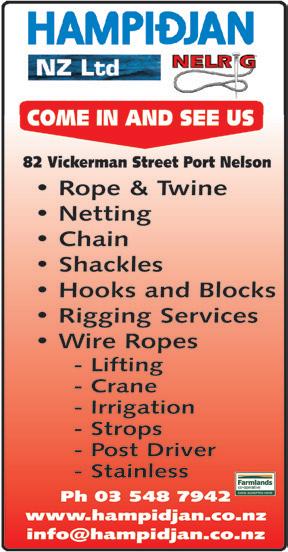

He reports locals were saying there are reasonable sequestra tion rates in extensive grazing land.
The meeting thought this could be an important offset and a sig nificant sink for long-term carbon sequestration and greenhouse gas mitigation which the government is not even considering.
• Rope & Twine • Netting • Chain • Shackles • Hooks and Blocks • Rigging Services • Wire Ropes - Lifting - Crane - Irrigation - Strops - Post Driver - Stainless Ph 03 548 7942 www.hampidjan.co.nz info@hampidjan.co.nz 82 Vickerman Street Port Nelson Marlborough Des McMillan 027 547 8717 Cnr Grove Rd and Farmar Street, Blenheim Motueka / Nelson James Marshall 027 706 5610 88 High Street, Motueka
NewsFarming TOP SOUTH MONTHLY November 2022 17
National list MP Maureen Pugh, Nelson Federated Farmers chair Stephen Todd and National’s Barbara Kuriger. Photo: Barbara Stuart.
Tree limits for offsetting agricultural emissions

Parliamentary Commissioner for the Environment, Simon Upton, recently released his report about the limits of planting trees to offset warming from agricultural methane.
He says that tree shouldn’t be discount ed however he has always had strong reservations about using forest to offset fossil carbon dioxide emissions.
He thinks there is a place for forestry to off set agricultural emissions but warms methane is a much stronger gas and the cooling effect of forests just temporary.
We need to know more about how much forest is required to make a useful contribution’s toward reducing climate risks.
The report also notes that while emis sions from dairy cattle have increased, emissions from beef, sheep and deer have decreased and that total livestock methane emissions have basically re mained constant since 2000.
One issue that Upton continues ex press is concern about the fact that fuel emitters have access to forestry to offset their emissions while the agricultural sector does not.
He says this makes for a playing field tipped against agriculture.
The report offers a different perspective on how NZ can deal with agricultural emissions what is apparent is there is a lot of confusion for landowners about how they can remain viable and meet 2030 targets and we can’t rely solely on trees.
The overall goal is to reduce agricultural emissions and options such as breeding animals that produce low emissions, vaccines and other tools are being de veloped.
Upton stresses that research into these areas is a high priority and to foster a better more informed debate about what is possible.
Tasman report from PGG Wrightson
 JOE BLAKISTON
JOE BLAKISTON
Another month has gone, and we seem to still be bombarded by issues and events from all directions. As I write this the Ground swell protests are underway across New Zealand against farming reforms and other climate responses that will penalise farmers, within days the roads between Blenheim and Nelson will be closed for six weeks to undertake criti cal repairs, the price of fuel and interest rates soar.
Putin holds the Northern hemisphere to ransom with his war on Ukraine and above all this the agricultural sector is still seen as the sav iour of New Zealand’s econ omy - that is a huge weight on a rural community.
Farmers and Horticulturists are under immense pressure to not only sur vive but also create foreign exchange while being delivered government policies that are unashamedly described as changing rural communities forever by allowing more tree planting and reduce farm carrying capacity to comply with emission rules. I do not deny the climate is changing when you see the massive rain events we have ex perienced in NZ Australia and further afield
- but I struggle with New Zealand being the country the “whole world is watching“ to see if we get it right as they shovel more coal into burners to keep their population with pow er and heating for the Northern winter.
There is a real need for a strong and uni fied voice to show the rural voice - howev er unfortunately the bulk of the voting power are those who do not understand the big picture - the problems for them are much closer to home with cost-of-living rises, struggles to make ends meet on urban household budgets and simply just get ting by. I suspect that we are in for a long debate on these matters as we head to an election in 2023 - I am sure there will be some surprises in store next year.
My best advice is to keep friends and family and advisers close to you over the coming months as the summer ap proaches - make timely decisions inside and outside the farm gate and keep communi cating no matter how tough things get - and above all get out and about in our wonder ful province. A and P shows are back on the calendar - at least COVID is history now, so we will see you at upcoming rural events and field days.
In March 2016 Hokitika woman, Merle Bradley participated in a successful wheelchair trial on the Abel Tasman National Park track.



Merle and her husband Neil trained for this adventure by exploring the full length of the West Coast Wilderness cycle trail.
Since then, Merle and many others have enjoyed the benefits of getting back into nature with the ViMo® all-terrain wheelchair.


You can too. Hire an attendant propelled ViMo® (generously donated by Hokitika Lions and Rotary Clubs) from the Hokitika iSite and get into the great outdoors

DESIGNED AND MANUFACTURED IN NEW ZEALAND Get back into nature with a ViMo® all-terrain wheelchair www.vimo.co.nz Better in the rough and ready for adventure The ViMo®all-terrain wheelchair features a patented frame design and intuitive controls making it comfortable and easy to use for both the occupant and the person pushing. Able to travel over difficult ground – handling river beds, mud, gravel and grassy paddocks with relative ease. Collapsing the ViMo® is quick and easy and when folded, it is compact, light and easy to carry with the inbuilt carrying handle. Conversion from attendant propelled to powered takes less than 2 minutes. Visit us at:
® www.vimo.co.nz | 021 43 63 53 18 November 2022 News Farming TOP SOUTH MONTHLY







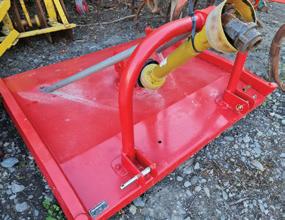
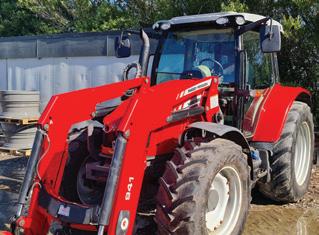
FARM MACHINERY & REPAIRS LTD Graham 021 228 3956 All prices plus GST Quality Used Tractors and Machinery • John Deere 1850 4x4 with very good loader, new clutch, new tyres and other work $23,500 • Massey Ferguson 135 Power steering late model. Coming in • Massey Ferguson 4255 105HP stoll loader 4600hrs. In workshop • Iseki 2160 22hp hydro in tidy order - $5,750 • Massey Ferguson 188 2WD loader, wet brakes, tidy order $10,750 • Howard AR 70” Rotary Hoe • Rata vineyard cultivator crumbler range of sizes available • Dual wheels Snap/locks 38” 36” 34” 30” from - $2,200 • 11 tyne & 13 tyne grubbers from - $1,500 • Duncan 3m Maxitill very tidy - $2,000 • Clough Contoura tidy order 14 feet - coming in • 9ft Cambridge roller - $1,800 • Trimax 1.8 Vineyard Mower, tidy order - $3,000 • Hydralada double in-row vine trimmer. Fully serviced with joy stick - coming in • Mole plough good order - $1,850 • Silvan G3 vineyard Sprayer good condition - $6,000 • Nobili VK135 mulcher - $3,500 • Silvan 600l herbicide sprayer electric controls - $5,000 • Fieldmaster M70 mower - $3,450 • Giltrap 2.1 vineyard side delivery mower - coming in • Farmguard 2.4m H-Duty Blade all hy control with land wheel - $8250 • Grader Blade 2.5 wide great order - $3500 • MF grader blade very good condition - $2500 Fieldmaster M60 Topping Mower. $3,200 No.3 Iseki 6500 and loader Uro hitch bucket good rubber 4x4 65 70hp good order $15,500 Massey Ferguson 5713 prem model Dyna 6 4 remotes 3300hrs prof model loader Good rubber Coming In Ero Double In-row Defoliator. Gen 2. Fully reconditioned with or without power pack. Kubota 5030 hydrostatic very low hours factory cab remotes. Coming in. Daedong 80hp 4x4 Cab & Loader, very tidy recon motor - $35,000 Iseki 6000 4x4 tractor with cab new front tyres 60 hp good reliable tractor. John Deere 6330 premium 110 hp JD self levelling loader very good tyres fully serviced and in good condition. $55,000 Massey Ferguson 5711SL 2900hrs, good rubber, excellent condition. Semi power shift 100 LPM hydraulics. Hard to find with low hours 110 HP. $88,500 AdvertFarming TOP SOUTH MONTHLY November 2022 19
Keen on working in the outdoors
BARBARA STUART
Kohri Brown has always been keen on outdoor ac tivities and knew at school that’s where he’s happiest and where his working fu ture was destined to be.
While in year twelve at Marlborough Boys Col lege he chose the Gateway program where a student works one day a week in their chosen career. Kohri chose a sheep and beef farm.
Now he has a job in the Wairau Valley, and it’s lived up to his expecta tions.

Brought up on a dairy farm at Pelorus Kohri al ready understands about stockmanship and rural life so it came as no sur prise to his family.
Kohri says, he wanted to try something different than dairying.
Six months ago, he en rolled with the Industry Training Program, Pri mary ITO which provides ongoing learning in mod ules. Once a fortnight he joins a Zoom meeting
with his tutor and con nects with others on the Course and at times they catch up face to face too. Kohri says he enjoys meet ing others on the course who have similar interests. He keeps up with his writ ten work in the evenings and weekends when time allows and says he’s not finding it difficult with the support he gets and the fact he is doing the prac tical aspects as part of his farm work.
He’s enjoying working for Simon Fowler on the sheep and beef farm learning the seasonal tasks of lambing, docking and especially he gets a real buzz when out mustering on the hills.
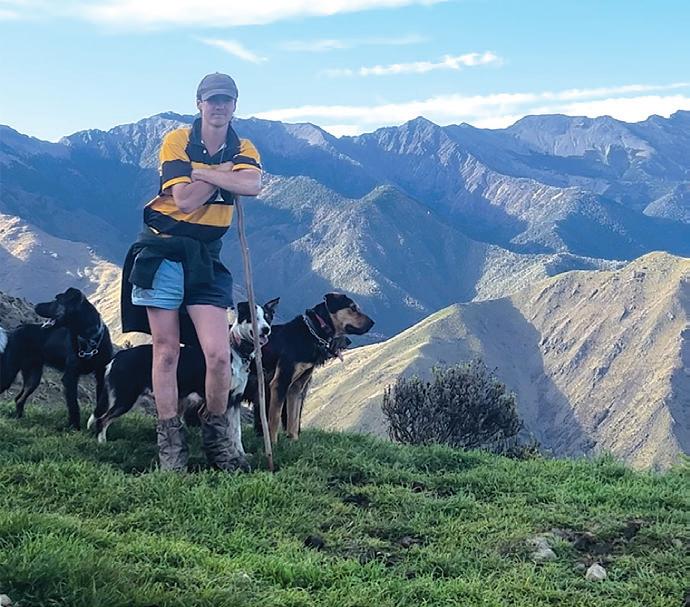
He says when he’s out mustering and observing the stock doing and well, he gets a real sense of sat isfaction.
Especially when working his dogs, moving stock and then shutting the yard gate on a mob of sheep af ter a big muster.
He knows he has more to learn but says this is the life that makes him happy.
Sitting pretty on the top of the hill, this home will certainly not disappoint, from the second you drive down the tree lined driveway, you will be immediately impressed by the architecturally designed 350m2 home with its warm timber features and bold South Island schist cladding.

Recently renovated, including a new designer kitchen complete with butler’s pantry and new flooring the home is open and bright, opening out to the sunny patio and large flat lawn beyond.
10.44 ha of rolling to hill grazing offer plenty of scope to run a few head of cattle, have some horses or lease it out, plenty of work has been done out on the land!
Price By Negotiation
Toby Randall M 027 233 9170
toby.randall@harcourts.co.nz


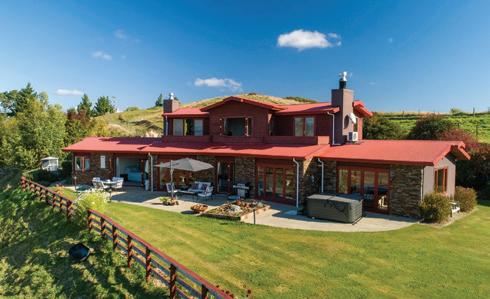




Y o u r L o c a l R u r a l a n d L i f e s t y l e E x p e r t s
Elegant, country living with views to match! 76 Teapot Valley Rd, Brightwater
20 November 2022 News Farming TOP SOUTH MONTHLY
Kohri Brown out on the tops with his team of working dogs. Photo: Supplied.
If you’re going to take on the challenge of what Dairy farming is, and the hard work that comes with that, why wouldn’t you want to give yourself the very best chance of success...
This premium and very productive dairy farm has so much to offer to its next owners. The 96.2 Ha highly productive block, currently milks around 300 girls, producing a whopping 140,000 KGMS approx. (6 year average), with the support of a couple of smaller blocks for producing supplement feed, and wintering some of the stock. The milking shed is a spacious and easy to run 24 A/S HB with a sizable circular yard, and concrete feed pad at the exit of the shed. The property has good infrastructure and laneways/access including a large Tasman tank for effluent storage, multiple farm sheds and large workshop with pit, PK/ Fert bin, concrete floor silage pit, good calf rearing sheds and more. There are two homes for owner and/or staff accommodation. If you would like the additional information on this fantastic property, get in touch with me now.
Tender Closing 16th Nov 2022
Toby Randall M 027 233 9170
toby.randall@harcourts.co.nz
Sharyn Miller M 021 377 930 sharyn.miller@harcourts.co.nz
Of the 51.87 HA, 23.77 HA are planted in a variety of apple and pear trees, over 46,000 plants, with irrigation rights in place. The balance of the land is utilized for other improvements, including large pack house, cool store, workshops and a bonus of approx 30 HA of easy to steep hill planted in exotic forestry and natives. Excellent accommodation options for seasonal staff with stand alone workers cottages and a RSE accommodation unit, plus the main 4 bedroom dwelling, that has been renovated on an elevated sunny site – complete with a sea view. For more information or to register your interest, contact Toby Randall.
Sale Details: Tender
027



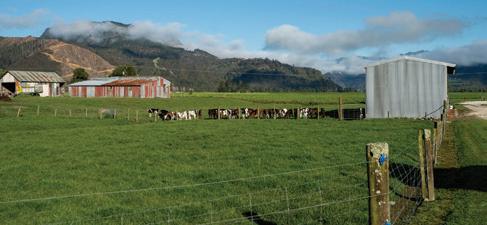
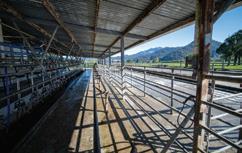

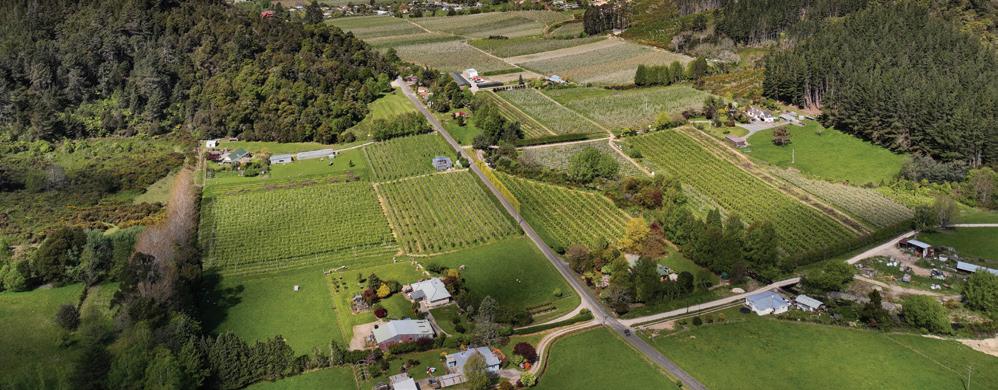
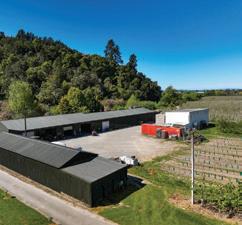
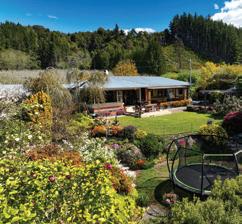




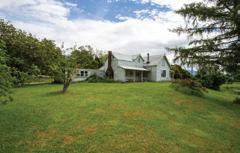

 Fertile Four Rivers Plains 24 Cole Rd, Murchison
Vaila Orchard Riwaka Tasman 85 Brooklyn Valley Rd, Brooklyn
For the first time if 150 plus years, this established family owned orchard with quality production history is offered to the open market.
Toby Randall
Fertile Four Rivers Plains 24 Cole Rd, Murchison
Vaila Orchard Riwaka Tasman 85 Brooklyn Valley Rd, Brooklyn
For the first time if 150 plus years, this established family owned orchard with quality production history is offered to the open market.
Toby Randall
M
233 9170 toby.randall@harcourts.co.nz
Tender Closing 30th Nov 2022
In the heart of golden dairy country 987 Takaka Valley Highway, Takaka Harcourts Rural is proud to bring to the market this family run dairy farm. The difficult decision has been made to sell and the Vendor is looking forward to the next chapter in life. The property has been conservatively farmed and is ready for a new owner to bring it up to its full potential. There are three Titles of flat terraces and rolling hills. Improvements include the main house originally built in 1870 which has four bedrooms and two bathrooms, the two other dwellings are both three bedrooms. The farming infrastructure include a 40 A/S Herringbone milking shed), multiple implement sheds and two purpose built calf rearing shed All viewings and property information to be arranged through Sharyn Miller
AdvertFarming TOP SOUTH MONTHLY November 2022 21
Tasman, we’re looking forward to hearing from you
Our next round of community engagement is about to begin as we prepare to draft Aorere ki uta, Aorere ki tai – Tasman Environment Plan (TEP).
In 2020, you shared your views and experiences on the District’s environmental and development issues and opportunities. We now have some draft options to consider around how we grow as a District, how our places look and feel, and how to care for our environment.
Staff and Councillors are keen to have conversations with you about some of Tasman’s tricky issues and options for how we might address them through the TEP.
Warmer months herald closer watch on water use
The 2022/2023 summer season started on 31 October and with that comes the need to keep an eye on how much water we use during the warmer months.
We are currently updating our data which relates to the state of our aquifers, river flows and groundwater levels. This is of particular interest to Waimea water users due to the susceptibility of this area to water restrictions.
The results are expected to be presented in mid to late November and will provide a useful basis for the Dry Weather Task Force in making water rationing or restriction decisions this summer. For consent holders in the Waimea Affiliated and Unaffiliated water management zones, it’s important to note that the Waimea Dam will not be operational at the start of this summer season.
Therefore, water volumes and rationing levels will be as per your resource consent predam authorised limits.
For the rest of us, any rationing for the Tasman District over this summer season which is not already subject to individual resource consent rationing triggers will be applied using Section 329 of the Resource Management Act 1991 in consultation with the Dry Weather Task Force. While we have had some significant rainfall over the winter months – it can only take a few weeks of dry or windy weather and increasing water use to result in aquifer levels and river flows dropping quickly.
This will then require water restrictions or rationing to be implemented. Our website has a page dedicated to how water use is managed in Tasman, visit tasman.govt.nz/water.
What we learn will make a difference in how the TEP is shaped. Initial community engagement opportunities have been scheduled for the following times;
• Saturday 5 November, Wakefield School Gala, 3.00pm – 6.30pm
• Saturday 12 November, Tākaka Market, 9.00am – 1.30pm
• Sunday 13 November, Motueka Market, 8.00am – 1.00pm
• Saturday 19 and Sunday 20 November, Nelson A&P Show, Richmond Showgrounds, 9.00am – 4.00pm
Webinars on Wednesday 16 and Thursday 17 November will also provide an overview and an opportunity to ask questions on areas you’d like to know more about.
A full list of engagement and feedback opportunities – including dates and times - can be found on our project web page. More events will be added to this page as they are confirmed.
There, you’ll also find discussion documents on key aspects of the plan as well as feedback forms.
Visit shape.tasman.govt.nz
Workable way ahead found with farmers as Stock Control Bylaw adopted
Having heard and worked with the rural sector in recent weeks, an improved final bylaw has been adopted to enable a workable way of managing stock crossings and droving on roads in Tasman District.
Seasons of soil sampling return
Our next round of soil mapping work is underway and with around 80,000 ha to map between now and June 2023, we certainly have a lot of ground to cover across the Tasman District.
It’s all worth the effort – the work we’re undertaking, and the information gained will be used to complement the national soil map of New Zealand.
Our field team was recently out and about in Motueka and surrounding areas. Soil mapping will then continue through spring, summer, autumn and winter as we plan to sample some of the soils at Wai-iti, Brightwater and Tapawera.
If soils get a little dry in summer, we will take a breather while we wait for some rain. We want to keep things sweet with property owners – if your land is of interest, you will be contacted by members of the field team in advance.
It’s also important to mention that soil mapping is a largely non-invasive procedure. It differs from soil testing in that samples are not generally taken from the sites visited, but rather involves a visual assessment of the soil.
A soil auger is our preferred tool of choice to drill a one-metre-deep hole into the ground and lay the soil material out in a half pipe to describe the colour, texture and other properties. The hole will be backfilled after the visual examination.
Often, a cut in the road or riverbank provides exactly what we need without having to make a hole. More information can be found on our website, tasman.govt.nz, search ‘valuing our soils’.
The Stock Control and Droving Bylaw 2022 comes into effect on November 1 and is intended to ensure the activity goes ahead safely for drovers, animals and all people that use our roads.
It reflects the changes sought by a hearing panel following submissions received. It now allows farmers more flexibility to do what best suits their specific circumstances, while still ensuring the safety of all road users.
This allows us to still meet our objectives, but in a way that is more workable to farmers.
Golden Bay Federated Farmers President Cherrie Chubb said she “was heartened by the constructive approach by all to get a more workable and practical bylaw established.”
The bylaw requires drovers to make reasonable efforts to avoid effluent on the road and includes the removal of specific requirements as to how the road is kept clear of excessive fouling for crossings – including the 50m set-back requirement.
Strategic Policy Manager Dwayne Fletcher said submissions made it clear that most farmers take their responsibilities to their community very seriously and are already doing a lot to ensure safety.
“We thank the farming community for their positive engagement with the process and helpful suggestions. Staff even took up invitations to join a couple of droves.”
“While we didn’t get it all right in the draft, the process added huge value to the end product.”



22 November 2022 Advert Farming TOP SOUTH MONTHLY
When are they going to do something for the farmers?
MAUREEN PUGH National List MP

Forgive me for asking such a bold ques tion, but as an MP I come into contact with a huge diversity of people. Take the recent Agfest as an example: an incredibly successful event which spread wonderful rural-based vibes all over Grey mouth’s Aerodrome for two days.
But people were angry. They were frustrated beyond any description I could write here.
Folk from both town and coun try told me of the frustration they feel about how primary producers are being treated these days and how rules and regulations plus rap idly-rising costs have conspired to make farming, cropping and all sorts of rural contracting, very hard to make money in.
Then there were the two rural issues meeting we held: Tapawera and Murchi son where the government’s farm emis sions proposal was top of the discussion list. This scheme would see farmers will pay for emissions from 2025, which could mean a 20 per cent reduction in sheep and beef farming.
Not only would that decimate rural com munities, but it would price farming out of New Zealand so that jobs and produc tion shift offshore to countries that pro
duce more emissions. New Zealand’s sac rifice would be for nothing.
The reaction from frontline people at those meetings was swift and clear: the effect on rural communities will be dev astating if people are forced to leave the districts they once worked in. Schools, freezing works medical facilities would be top of the casualty list.
The more recent Groundswell tractor protests in the four main centres show the depth of feeling about the far-reaching conse quences of Labour’s proposal.
Let me be clear: National is ab solutely committed to bringing down emissions and we know that lowering agricultural emissions needs to be part of the solution. But tech nology, not bankruptcy, is the way to low er agricultural emissions.
My hope is that the feedback is listened to and a more pragmatic direction to emis sions reduction and offsetting is found. I find it very upsetting that this government simply don’t realise how much a proposal like this shakes the confidence of the sec tor, at a time when we need investment and forward-thinking.
This is all about respect for the primary industries sector. So, how long will it take for the government to realise the enor mous debt that we all owe to our primary producers?
A healthier way
Empowering your spring growth
Taking advantage of the wet start
Magnesium is

The
HWEN not best for us
STUART SMITH Kaikōura MP
The Prime Minister is de livering on her ambition to lead the world in pric ing agricultural emissions by announcing the Gov ernment’s proposal to levy farmers for their emis sions. It is ironic that the one thing she may deliver on will put us in breach of Article 2.1 b of the United Nations, Paris Agreement. That is to not threaten food production. The Paris Agreement took effect in New Zealand in 2020 when food security was a third-world issue, today, however, it is much more widespread and therefore, even more im portant today than it was in 2020. The Government es timates that their propos al will lead to almost 20% of sheep and beef farm ers being forced to leave farming. A clear threat to food production. Sheep and beef farmers current ly generate around $9000 for every man, woman and child in New Zealand but it is likely that some of that
production will go on to be taken up overseas, where farming practices are less efficient and emissions per unit of production will be higher, thereby increasing global emissions.

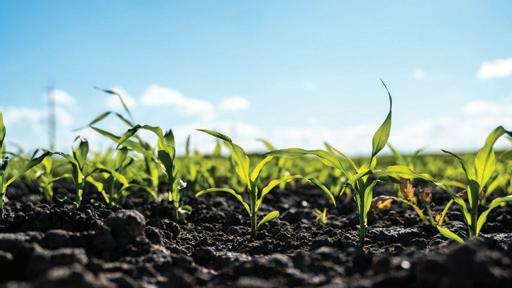
That begs the question; does the Prime Minister care about reducing emis sions to address climate change, or does she want to reduce New Zealand’s emissions regardless of whether that reduction leads to an increase in global emissions? I suspect it is the latter.
The proposal does not al low farmers to offset their emissions and claim credit for their on-farm plant ings, such as shelter belts and riparian plantings, be cause it is difficult to accu rately measure how much carbon they capture.
Yet Government plans to impose a methane emis sions levy on farmers based on an estimate of per-ani mal emissions, which are also difficult to accurately measure. How is that fair?
When the National Party supported the so-called Zero Carbon legislation,
we did so with a clear un dertaking that we in Gov ernment would take the following approach:
• A science-based ap proach. • A focus on in novation and technology.
• Long-term signals to the economy. • New Zealand to act with international partners – not in isolation.
• Consider and manage wider economic impacts.

Clearly, the Government’s proposal does not align with at least the last two points, and we will all pay the price for this.
National takes a more ra tional approach. Yes, we must reduce our emis sions, however, moving in isolation ahead of our trading partners will not reduce emissions to the at mosphere. Rather they will likely increase them as pro duction shifts elsewhere to less efficient producers, not to mention decimating one of our major export sectors and impoverishing us all. We simply should not let the Prime Minister’s am bition of leading the world in climate change comprise our best interests.
03 525 9843 | sales@goldenbaydolomite.co.nz www.goldenbaydolomite.co.nz Book a free soil consultation today
Stimulate plant growth as a calcium & magnesium carbonate
Calcium is important for healthy plant root, stem & leaf growth
essential
found at the centre of the chlorophyll driving photosynthesis
dual product benefit is both nutrients support healthy stock
Why you should apply Golden Bay Dolomite this spring:
It’s perfect timing to incorporate Golden Bay Dolomite into your spring crop planting & pasture renewal programmes, building soil magnesium reserves.
NewsFarming TOP SOUTH MONTHLY November 2022 23
Utilising trees to solve problems
1981, PJ Kenny,
oil rigger, and his kiwi wife
Pretty Bridge prop erty.
While working for his neighbour he was intro duced to the Farm Forestry Association and has been a member ever since. What attracted him to the or ganisation was the concept of utilising trees to solve problems on his land and learning about having the right tree in the right place to sort out an issue.


PJ says trees can be a longterm investment for build ing up capital whilst also providing benefits like shade for stock, wind pro tection and for locking up carbon or holding stream banks.
Over the past forty years attending Farm Forestry field days, he says he has learned a lot from others belonging to the Farm For estry organisation and at field days which he has ap plied on his own property. When he first purchased

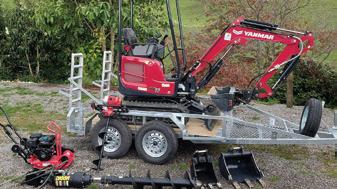
his property he was able to log a block which helped to pay off the mortgage, and since then has harvested six other blocks involving professionals from the log ging industry.

Over the years, he says, he has improved the land with roading and skid sites in place for future logging, leaving the land in a better state for sustainable har vest in the future and for
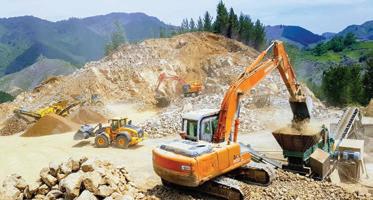

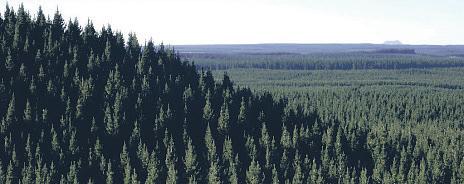
providing employment. Another benefit of field days is getting people to gether where they can talk about long-term solutions for issues like gravel buildup, blanket rules that are not working in extreme weather events, the lack of root holding capacity from our indigenous biodiversi ty and the need to use in troduced species in the fu ture alongside native trees.
He is also an advocate for systems of settling ponds in creeks and rivers, wetlands for filtering sediment and their water-holding capac ity, and their ability to take energy out of a fast-flowing stream. PJ says the Farm Forestry Assn is a great place for picking up knowl edge. Robert Appleton will be discussing topics like these at the November 26th Field Day at his Motupiko property in conjunction with the Upper Motueka Catchment Group.
PJ also says, forestry had a bad reputation in the past but for the future he thinks it plays an important role for sustainability on the planet as a renewable re source. Alternative spe cies like redwoods, cyprus, ground durable eucalypts currently don’t always pay but have potential. Radiata pine is the financial engine for research and develop ment that will bring those other options to fruition at some point, it’s just not happening yet.
Nelson Farm Foresters Association

Environmental Management Fielday






Saturday 26 Nov 22 at
Appletons Motupiko Forest

TDC Borlase Forest
Upper Motueka River Catchment
Meet at Memorial opposite Flat Rock Cafe, Motupiko at 9am
Bring lunch
Non-members welcome
Cost: Donation
Trees for sale
een a me y Associa Apppleton s has s beeen a meember of NZ Farm Forest A ociation for over 50 year Please note constraints. adver tisingpr oof Please check your proof carefully and approve it or submit corrections by the Final Proof Alterations deadline. Yo u can now appro ve or submit changes to your ad within the ATOL system at a time that suits you. Just follow the link in your ad proof email to view your ad, then cl ick the APPROVE or CORRECTIONS button right from there no new emails required! The any PF Olsen is the leading provider of independent professional forestry services in New Zealand. Contact us now for all your forest management needs: • Harvest management and log marketing • Forest establishment and tending • Forest valuations • Due diligence on forest purchases/sales CH-8994297AA Nelson 03 544 0066 Blenheim 03 577 6675 customer PF OLSEN & CO LTD (RMD) publishing 06/24/21 booked size CSQ QUART VE advert ID CH-8994297AA (100%) publication Adv Supp NEM dimensions 12.3X12.4, cms width by height section CUSTOM SQUARE proofed 9/06/2021 12:22:08 PM adver tisingpr oof approve it or submit corrections by the Final Proof Alterations deadline. Yo u can now the ATOL system at a time that suits you. Just follow the link in your ad proof CORRECTIONS button right from there no new emails required! The Professional Forest Management Comp of Choice. PF Olsen is the leading provider of independent professional forestry services in New Zealand. Contact us now for all your forest management • Harvest management and log marketing • Forest establishment and tending • Forest valuations • Due diligence on forest purchases/sales CH-8994297AA Nelson 03 544 0066 Blenheim 03 577 6675 customer PF OLSEN & CO LTD (RMD) publishing 06/24/21 booked size CSQ QUART VE advert ID CH-8994297AA (100%) publication Adv Supp NEM dimensions 12.3X12.4, cms width by height section CUSTOM SQUARE proofed 9/06/2021 12:22:08 PM The Professional Forest Management Company of choice PF Olsen is the leading provider of independent professional forestry services in New Zealand. Contact us now for all your forest management needs Proudly Supporting The NZ Farm Forestry Field Day npd.co.nz Rowan Coutts 5 Factory Rd, Brightwater Ph: 0800 111 247 or 03 542 2068 Cell: 027 596 3180 E: rowancoutts@ryco.net.nz Your local Call, Connect & Go Hydraulic Specialists Proud to support NZ Farm Forestry Association Nelson Branch Field Day Nelson Proud to support NZ Farm Forestry Association Nelson Branch Field Day Your local Call, Connect & Go Hydraulic specialists. Rowan Coutts 5 Factory Road, Brightwater Ph: 0800 111 247 or 03 542 2068 Cell: 027 596 3180 489 CHURCH VALLEY RD, WAKEFIELD BEN.PALMER303@HOTMAIL.COM @PALMERDIGGREHIRE Ben Palmer 027 404 6365 24 November 2022 Feature Farming TOP SOUTH MONTHLY In
an American
purchased their
Ornamental
PJ Kenny at his Pretty Bridge property.
Opinion: Immune to false packaging
 GARRICK BATTEN
GARRICK BATTEN
Packaging sends messages about the product it wraps with images, words, colours and links to other messages. Those may be specific or presumed.
Are we becoming so used to ex travagant and misleading claims that they are now accepted, and worse still exaggerated in various media or by personal agendas?
What does “clean” actually mean to describe a product or the result of using it?
Other words are misleading such as the various forms of fake meat and milk proclaimed as needing 45% less energy or 76% less wa ter or generating less emissions. Less than what? Or having more nutrients than what? Apparently
Einstein’s lessons of relativity no longer apply. Or maybe fake meat is being compared with real actu al meat but even that needs to be quantified. Is it pork or chicken from so-called industrial produc tion, beef from feedlots, or lamb from free-ranging Merinos that all have different production bas es and effects?
We have various media shouting similar proportionate compar isons to criticise New Zealand’s methane reduction target as be ing only 10% compared with UK 30%, EU 30% and Ireland 25%.
But the reduction must be relat ed to the total and also the pro portion of total emissions. And then further considered from our point of view compared with sub sidised food production systems
in those other countries.

Other packaging words carry emotive messages based on ques tionable facts. Farmers have their own names for livestock young such as lambs, calves, fawns, foals, kids and chickens.
Calling them babies not only
Crunch time for new freshwater legislation
Oscar Savage Graduate Planner, Baseline Group Marlborough

In 2020, Central Government released an abundance of Freshwater Policies, including National Policy Statements (NPS-FW) and National Envi ronmental Standard for Fresh water (NES-FW), and adden dums to the RMA bringing in Freshwater Farm Plans and Stock Exclusion Regulations. As we near the end of 2022, push has come to shove, and these regulations are starting to take effect. Understanding what the raft of regulations will mean for farmers is im portant to ensure regulatory compliance for our agricultur al sector.
Freshwater Farm Plans are management tools used to identify and implement prac tices to oversee the impact of farming activities on Freshwa ter.

Freshwater Farm Plans are tailored to individual farms and follow catchment-level directions about the individ ual needs of each catchment.
Freshwater Farm Plans achieve this through risk identifica tion, impact assessment and planning actions to mitigate risks.
This includes detailing how existing freshwater legislation will be met including intensive winter grazing restrictions and stock exclusion regulations. Any farm with 20 ha or more in arable or pastoral use, over 5
ha in horticultural use, or over 20 ha of mixed-use will be re quired to have a Freshwater Farm Plan.
Government has anticipat ed farmers will be able to put together their plans; however, specialist information from primary sector groups, advi sors and regional council will be necessary.
Regardless of who writes them, the plans will be certified and audited by a qualified certifier or farm advisor, to ensure the plan is fit for purpose and re port back to Regional Council.
Certification ensures the plans are consistent on a region al level and heading towards achieving a region-wide im provement in freshwater qual ity and quanitity.
Restrictions on intensive win ter grazing were raised in the NES-FW in 2020 and were to
come into effect in May 2021; however, this was put off until November 2022.
The restrictions establish per mitted standards farmers must operate within for winter graz ing, or seek resource consent.
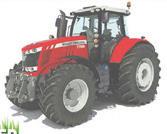
The permitted activity stan dards require a Freshwater Farm Plan, controls the total area of a farm that can be used for intensive winter grazing, slope and setback from water ways, among other things.
Stock exclusion regulations are generally coming into force in July 2023 for dairy cattle and July 2025 for dairy support cattle.
These regulations require dairy cattle, dairy support cat tle, deer, and pigs to be exclud ed from the area 3 m from the edge of a bank of a lake or river over 1 m in width unless they are accessing a bridge, culvert, or are driven directly through the waterbody no more than twice a month.
These regulations have been deemed necessary by central government due to the im portance of freshwater to the health of our communities and environment.
Beyond best management practices applied daily on farm, freshwater management requires a holistic look from a regional and catchment level to ensure the improvement of our freshwater for future gen erations, which is the primary aim of the Freshwater Farm Plan process.
demeans human youngsters but conjures an image unlike real farm animals. And calling chil dren as kids mislabels both. It has probably gone too far from finger lickin’ to remind people that eggs are produced by hens not chick ens.
But not too far for farmers to re mind consumers they are eating meat produced by animals, not humans.
And meat that really is gluten free, GE free, nuclear free, and more free range than from your average human using plant foods.
People who sell real meat know customers buy on price, taste, tenderness, succulence, flavour, consistency for great eating.
When we look at the packaging of fake meat itself, an example is
Boer Free Bacon with a mislead ing image of a large pig on front, repeated on the back. But it isn’t made from a pig at all. It is made from peas in a secret industrial system and claimed to be lean and clean from a process with different clean standards. Why not an image of a pea plant? And made from imported products so the carbon emissions to produce and ship them here and soil car bon loss and emissions to grow the peas are ignored. Why should we be importing food products to make fake meat when our farm ers already efficiently produce real meat products that help feed the world?
The breakfast team verdict?“That ain’t bacon.” They were pe aed off.
Returning to his rural roots
Grant Ruthven, Farmers Mutual Group’s new mobil rural consultant for Tasman, Marlborough and the West Coast was born and raised on a small farm on the Taieri Plains in Otago. His first job was as junior herd manager milking cows on a dairy farm. Grant says, taking on this new role means he is returning to his rural roots in the agriculture sector.
Based in Nelson, with his family, who he enjoys spending time with and pursuing interest like fishing,
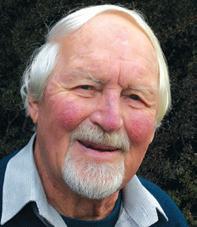
trial biking and mountain biking he is enjoying exploring new places, he says, this job provides plenty of op portunity to do that as he visits new clients. Prior to working for FMG, Grants has held down positions in Agriculture, Horticulture, tourism, and Waste Management. He also has qualifications in agriculture, ad venture tourism and arboriculture. Grant says he is keen to be able to provide personalised advice to Ru ral people which helps then to pro tect their livelihoods.
Anna and the team are land development experts and can help with all your resource consent needs around the farm.
Get in touch about your next project, and with their experience and expert knowledge they’ll save you time and unnecessary cost in preparing your resource consent, giving it the best chance of being approved without delays.
Our primary logo is the full colour version shown at right. Alternative versions of the logo have been created (as shown on the following pages), but this version is always the preferred option. If space does not permit this logo in its full horizontal format, you may use the logo shown on the following page, or rotate this logo 90º and use it vertically (as shown below). This version is only to be used when absolutely necessary. Logo 5 BASELINE GROUP BRAND GUIDELINES 2018 Your core services are shown as a standardised lockup for consistency. This is available in landscape and portrait orientations. Services Lockup SUPPORTING ELEMENTS PLANNING | SURVEYING | ENGINEERING PLANNING SURVEYING ENGINEERING HORIZONTAL LOCKUP VERTICAL LOCKUP P. 03 578 7299 anna@blg.nz www.blg.nz MARLBOROUGH SUBDIVISIONS AND BOUNDARY ADJUSTMENTS WATER PERMITS SEPTIC TANK DISCHARGES EARTHWORKS CONSENTS For all land development, cultivation, direct drilling, re-gassing, mulching, maize planting, apple tree planter, round and medium square hay and baleage sales and production Mark: 021 454 000 Email: mark.carey@xtra.co.nz 28 Holdaway Rd, RD2 Upper Moutere Nelson 7175 New Service - Apple Tree Planter NewsFarming TOP SOUTH MONTHLY November 2022 25
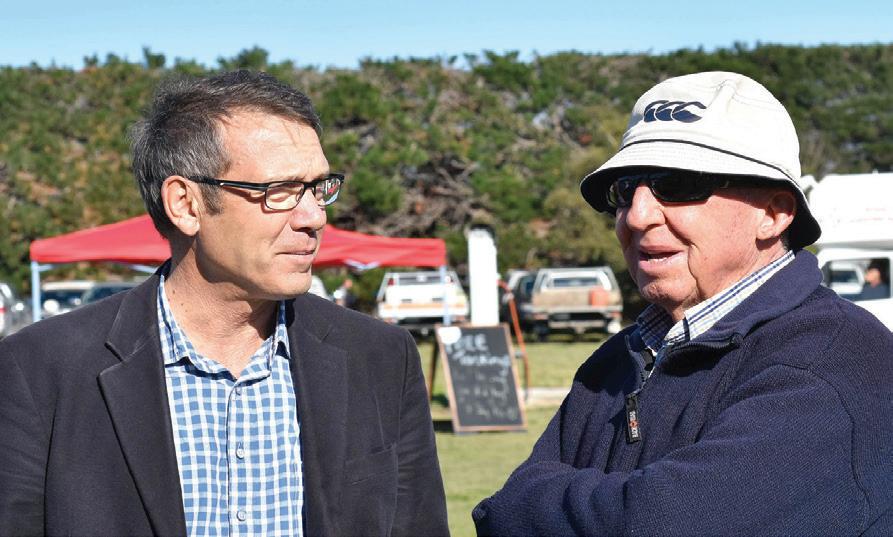

Blenheim Electorate office 22 Scott Street, Blenheim 03 579 3204 - 0800 STUART stuart.smithmp@parliament.govt.nz Let’s talkI’m listening Authorised by Stuart Smith, Parliament Buildings, Wgtn. Stuart Smith MP for Kaikōura Electorate 26 November 2022 Advert Farming TOP SOUTH MONTHLY
WEST COAST
Fifth generation farming on the Coast
 BARBARA STUART
BARBARA STUART
Andrew and Jill Stewart are fifth generation sharemilkers situat ed on the edge of the Taramakau River on state highway 73, not far from Kumara.
They operate a 234-cow herd on one of the family blocks. An drew’s parents are on the home farm while another brother runs a beef herd over the river. An drew say’s his great, great, great grandparents arrived in the area during the Hokitika gold rush, and the family has been there ever since.

The couple have been share-milk ing for about ten years they op erate a traditional low input all grass system, buying supplement as required. He has a policy of
“least number of trucks in the gate and maximum of produce going the other way.”
Andrew says, he tried once a day milking for three years but in the end found they were missing out on the peak production months and those important returns.
More recently he has found what works in their situation is once a day milking over calving for one month then they jump to twice a day over the peak season until mid-December when they switch to twice daily three days a week with the other four days on once a day. Once they hit March its back to once a day until they dry off.
This regime means they get some family time with their three young children, have time to get
other jobs done and manage their own energy better.
Andrew is also involved in Fed erated Farmers; he says the work
they do advocating for private landowners is impressive and vi tal for all landowners. They tackle important issues impacting the
wider rural sector which is often taken for granted.
One of his farming interests is how to make de-budding of heif er calves less of an animal health risk to the sector.
Somehow, he can’t explain how, the polled gene turned up in their herd. They ran all the genetic tests and found it to be a natural ly occurring thing! Both LIC and CRV Ambreed are working with him to generate bulls carrying this gene for the national herd.
This season of the sixty heifer calves he’s kept one third did not require de-budding.
The process of de-budding re quires calves at four weeks old to have an anaesthetic to remove the buds which left can cause other issues.
Westport Whitebait Festival a success
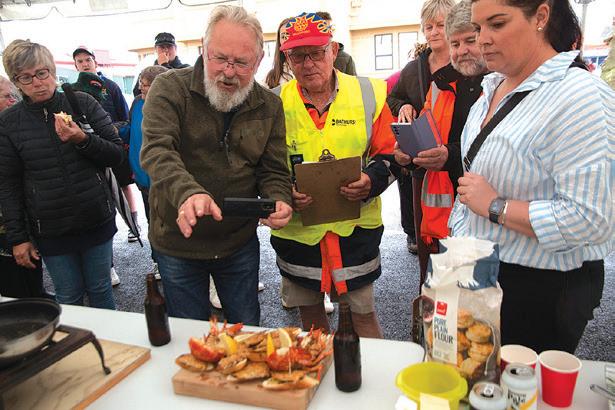 DARYL CRIMP
DARYL CRIMP
A light dose of ‘Buller sunshine’ wasn’t enough to deter foodies, the adventurous and disciples of the frontier spirit from embrac ing the annual Westport White bait Festival over Labour Week end.
Droves of locals and visitors were happy to fritter away Saturday en joying the stalls, entertainment, live music and food, despite light drizzle persisting. The main street was closed to traffic, which created a relaxed a spacious feel and ambience but it was white bait people came for and, despite a lacklustre season, they weren’t disappointed. A couple of stalls were kept busy cooking up white bait patties, the delicate aroma drifting down Palmerston Street enough to ensure a steady stream of hungry clientele.
A highlight of the entertainment was the Whitebait Filleting Com petition, which was hotly con tested by teams representing St John Ambulance, Talleys and The Fire Brigade. Each team com prised of members vying for a spot in the finals. The objective: to head, tail and fillet 20 white bait within three minutes. Points were awarded for technique and presentation, with the ultimate award taken out by The Fire Bri gade, which competed in full re galia and with the ‘Jaws of Life’ as back up.
The main drawcard, however, was the Whitebait Cook Off, which attracted seven teams: the four schools—North School, South School, Buller High and St Can ices—South Peak Homes, Mitre Ten and Buller Rugby. Contes tants had 30 minutes to create a whitebait dish in their own style and were scored on presentation and taste: 10 points each catego ry for a possible high score of 20. With ‘Crimpy’ as Chief Judge and open to bribes, an impromptu ‘panel of four judges’ was hastily
cobbled together to balance the field, with Richard Fairbrass and Jonathan Taylor stepping up, and Gemma Rout reluctantly second ed from the audience.
The results impressed the crowds and stunned the judges. With only two-burner cookers to work on, the teams excelled, delivering a Masterclass lesson in whitebait cuisine. The classic fritter with white bread, butter and lemon juice formed a central theme, with most teams either adapting the recipe with a twist, incorpo
rating it into a themed dish or innovating a new recipe entire ly. The Judges were impressed with the variety of flavours and the high standard of presenta tion. Dishes to impress included Whitebait Pattie with fried Māori Bread, Whitebait in Beer Batter, Whitebait Benedict, Whitebait Dumplings and Whitebait Patties with Stuffed Grilled Mushrooms. Many of the dishes were even accompanied by a beer match, such as the innovative Whitebait Cucumber Canapé matched with
locally brewed Cucumber Beer. Such was the calibre of the en tries, the judges deliberated at length to select a winner, saying the standard was so high it came down to fractions of a point in the end. South School took out the prize for Best Presentation with their twist on White bread and Pattie, while North School won the Innovation Award for their Whitebait Three-ways: white bait with fried Māori bread, in beer batter, and with homemade white bread—accompanied with a craft beer match. Buller Rugby got over the line in third place by bribing Crimpy with crayfish and Buller High scored second place with the best Pattie.
The supreme award was taken out by St Canices with a stun ning Whitebait Ramen Dish: a Japanese style noodle soup with whitebait cooked three ways— pattie, individually fried and in a cabbage & spinach dump ling— served in a fish broth and topped with a Ramen egg. The Judges said, while complex, the presentation epitomised this style of dish and it was well executed. However, when all the elements came together in the spoon, it produced the perfect marriage of ingredients, came alive and cre ated a flavour sensation that was truly unique.
Put a ring around next Labour Weekend—The Westport White bait Festival is not to be missed.
West CoastFarming TOP SOUTH MONTHLY November 2022 27
Andrew and Jill Stewart, with the sixth generation. Photo: Supplied.
Westport Whitebait Festival 2022 Judge Daryl Crimp. Photo: Supplied.
TASMAN

Nelson Federated Farmers Report





Federated Farmers made anoth er submission on climate change policy changes for split gas emis sions budgets, with concerns over emissions leakage and the ETS, and unsustainable afforesta tion, other issues of political sup port and a climate dividend, and the need for zero-carbon equiva lent biogenic methane reduction targets. So it recommended that govern ment should request the Climate Change Commission to advise what reduction in biogenic meth ane is required to ensure that the GHG has an impact on atmo spheric temperature equivalent to zero long lived emissions (zero carbon equivalent); or if a bio genic methane emission reduc tion target(s) figure is required to be stated in the CCRA, then
amend the biogenic target(s) so that it is based on a 0.3 percent reduction per year which equates to about 3 percent by 2030 and about 10 percent by 2050. That has now been overshadowed by the current focus of members and all farmers on government’s response to the agonisingly craft ed HWEN proposal.

export income. The results will drive farming off hill country in particular, to be replaced by trees yet HWEN farm sequestration proposals were rejected.
Worse still, government propos es to sacrifice all people in rural communities as socio-econom ic aspects will be considered as secondary. Another coffin nail is setting a reporting date of 1 Jan uary that ignores realistic farm accounting dates.
als for their political masters are based on the best of limited knowledge and understand ing of reality, and agriculture is swamped at political levels de spite its critical place in our econ omy, environment and society,
dividual farmers do not have the time and sometimes the appreci ation of the government’s moves in this complex subject.
Federated Farmers, DairyNZ and Beef&Lamb NZ continue to call to delay the Winter Grazing Reg ulations for a further year. They have already been delayed twice on the basis that certified Fresh water Farm Plans would become available.







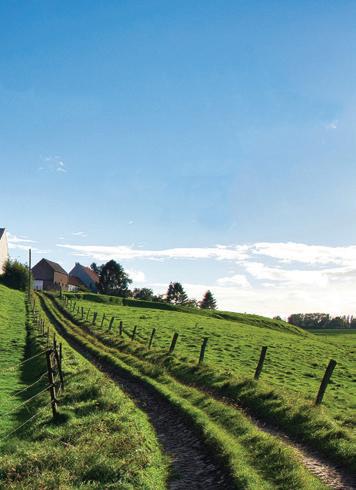
Introducing Doug Smith
I
In the personal and political de sire to lead the world it will push NZ as the first country to price agricultural emissions, and con currently ignore their agreement not to reduce food production. But also destroy pastoral farm ing.

If there ever was a reason for farm industry unity it is now. Wellington bureaucrats do not understand farming.
marketing tailor made to

Government modelling shows annual net profit loss of 21-24% on sheep and beef farms and 6-7% loss on dairy farms, as well as reduced food production for
Doug Smith
Doug Smith
More examples are the strangu lated hernia of ideological immi gration policy, banning live ani mal sea export, and promoting exotic forestry over increasing hectares of farmland.
Motivation seems to be driven by wanting more control to apply one solu tion to the huge range of individual farm busi nesses operating different systems in diverse geo graphic and climatic en vironments.
Farmers know these dif ferences. These other people do not, partly due to MPI being gutted of practical farming experi ence for policy input. S o the myriad of scientists at Landcare Research, en vironmentalists at MfE and various academics advise parameters for new legislation and regu lations.
Bureaucratic propos

and will be swamped even more so in increased wetlands. Nationally, members ranked their concerns in an earlier sur vey. Even although there were some differences for stage of re spondents’ farming career and age, importance of policy issues was largely consistent across in dustry groups and across regions. Ranked priorities then were wa ter quality and quantity, RMA, and climate change, followed by regional water plans with water quality the most important issue. For district plans, the most im portant issues were subdivision, land use and biodiversity.
These are examples of the need for industry representation as in
It is already clear that certified farm plans will not be available for farmer decisions about plant ing winter crops this season, highly unlikely for actual winter grazing, and maybe not for an other five years for many farmers. Despite issues like these it is no wonder that as winter fades, spring bursts forth, milk flows and lamb skip that the latest Ra bobank Rural survey showed al though farmer confidence edged higher in the last quarter, but with farm input costs an ongoing concern sentiment remains deep in net negative territory overall. It was marginally up on the pre vious quarter, but the net reading was still –31 per cent.
The Nelson Province Board did not meet in October but social activities for all rural people con tinue with Waimea Rural Con nection’s CommuniTEA 1-3pm. on 4 November and 2 December, and AGCulture free meal and yarn from 6pm on 16 November and 7 December at Brightwater Scout Den.
Great opportunities to meet, chat and catch up, and also support what FF is doing for the rural community.
have been living and working locally since 2008. Use my experience, honesty, integrity and work ethic to deliver you the highest value for your number one asset. Competitive commission and
your individual requirements. I welcome your call for a no obligation appraisal Introducing
I have been living and working locally since 2008. Use my experience, honesty, integrity and work ethic to deliver you the highest value for your number one asset. Competitive commission and marketing tailor made to your individual requirements. I welcome your call for a no obligation appraisal and any advice I can give you. Professionalism Knowledge Competitive Pricing M 027 543 2280 douglasjcsmith@pggwrightson.co.nz M 027 543 2280 douglasjcsmith@pggwrightson.co.nz Introducing
I have been living and working locally since 2008. Use my experience, honesty, integrity and work ethic to deliver you the highest value for your number one asset. Competitive commission and marketing tailor made to your individual requirements. I welcome your call for a no obligation appraisal and any advice I can give you. Professionalism | Knowledge | Competitive Pricing Design | Engineering | Fabrication | Construction | Maintenance Proudly Supporting The Local Brightwater Community WWW.BRIGHTWATER.CO.NZ Design | Engineering | Fabrication | Construction | Maintenance WWW.BRIGHTWATER.CO.NZ Engineering | Fabrication | Construction | Maintenance Proudly Supporting The Local Brightwater Community WWW.BRIGHTWATER.CO.NZ Design | Engineering | Fabrication | Construction | Maintenance Proudly Supporting The Local Brightwater Community 28 November 2022 Tasman Farming TOP SOUTH MONTHLY
Farming TOP SOUTH MONTHLY Farming NEW SEASON BEGINS WITH RIGHT Ploughing Champs come to Seddon SOUTH Farming NEW SEASON BEGINS WITHTHE RIGHTTOOLS!PRE-PRUNERS www.tobyrandall.co.nz Toby Randall school vic entertained Handling high pressure 100% locally owned and operated RAYLENE WADSWORTH raylene@waimeaweekly.co.nz Phone: 027 458 9115 • Based in the top of the South Island we are 100% locally owned and operated • With Barbara Stuart, editor with extensive on the ground knowledge and a growing team of journalists and relevant editorial content to support her. • Delivered free to 14,500 rural mailboxes every month, from Greymouth, Westport, Nelson / Tasman, Golden Bay, Marlborough, Marlborough Sounds and everywhere in between • 20+ years of speaking directly to a target market for customers and readers alike.
“ Government modelling shows annual net profit loss of 21-24% on sheep and beef farms and 6-7% loss on dairy farms
TASMAN
Motueka catchment gets its funding
The Motueka Catchment Col lective has been successful in its bid for funding from the Ministry for Primary Indus tries Essential Freshwater Fund, winning $870,000 to be spent over the next three years in its application via the Tasman En vironmental Trust.


The funding will support com munity efforts to improve freshwater health, focussing at sub-catchment group and farmer level as well as with the matic groups on priority issues already identified through com munity meetings.
A tradition of community service
BARBARA STUART
Immediate past president for Nel son Federated Farmers, Martin O’Connor has served his commu nity in a variety of roles over many years.
He comes from the well known O’Connor family who have a tra dition of community service and is the son of Fergus O’Connor who was known for his life-long love of draught horses that were frequently on display at many lo cal shows throughout the region.
Martin didn’t follow in his fathers footsteps when it came to horses.
He says, as a fourteen year old at tending a scout jamboree his life’s passion for ‘Claybird shooting’ began and to this day he is still very involved in the Nelson, Tas man Claybird Target Club and has been for the past forty seven years.

In 1988 he escaped from the fam ily dairy farm and spent a season in Canada with the Agricultural Internation Exchange programme working on a grain farm, where he had a great time.
The experience cast a shadow of doubt over returning home to dairying, but return he did to
family responsibilities.
Throughout his life Martin has been an involved member of NZ Fire Service at Appleby, Tapawera and now Ngatamoti where he has played a pivotal role.
Martin’s networks throughout the district have been extremely helpful to the Regional Adverse Events Committee, Rural Support and Civil Defence during weath er extreme events like Cyclone Gita and the series of flood events more recently, plus during the Pi geon Valley fires.
He acts as a liaison person sup porting farmers and kifestyle landowners linking them to sup port and information. He also carried out the role of president for Nelson Federated Farmers for eight years.
Martin is a humble man who says he never wanted the job and thought there are better people out there for the role but the fact remains; he has done all of these things to the best of his ability when no one else would.
For that the rural community of Tasman and Nelson recognise him as a real asset to our commu nity.
However, with 30% of the pro ductive land use in the catch ment being forestry, the forest ry sector is a key component, and a Forestry Working Group has been set up that will devel op a strategic plan of action for the collective. Other thematic groups include river manage ment, biodiversity restoration, weed/pest control, and river ac cess and recreation.
It is good to see the recent emergence of a strong farmers group in the upper Motueka focused on river flood manage ment, working with the council and taking on that aspect. The collective will be be setting up a governance structure in the first year and have provision for re cruiting a catchment facilitator, support for iwi involvement and a catchment health monitoring framework that has stronger
community engagement. The subsequent two years will have more funding for the ini tiatives identified by the com munity groups, and they will be
working closely with others like TDC, New Zealand Land care Trust and Beef+Lamb with their extension programmes.

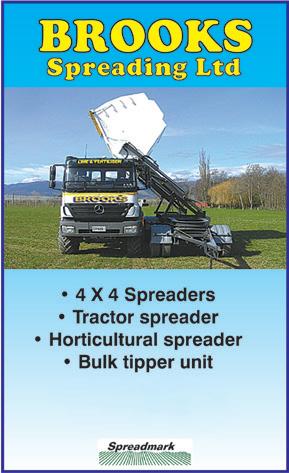
0800 542 383 Dean 027 431 4090 Ben 027 571 6003 TasmanFarming TOP SOUTH MONTHLY November 2022 29
Vicky and Martin O’Connor, appreciated for their leadership by Nelson Federated Farmers. Photo: Barbara Stuart.
Catchment Group planting day on Hamish and Jan Barkers Stanley Brook property. Photo: Supplied.
Locally Owned & Operated • GRAS S HARVESTING • BALEAGE • HAY • PIT SILAGE • GROUND WORK • SPRAYING • AIR SEEDER DIRECT DRILLING • MAIZE PLANTING & HARVESTING • EARTHWORKS • CARTAGE • SITE WORKS • DRAINAGE Paul 027 422 5893 Phil 027 372 9864 accounts@lesliecontracting.co.nz
marlborough

Marlborough Rural Women host fun day for flood victims
and stamping of feet.
In mid-October, Marlborough Pro vincial Rural Women New Zealand hosted a fun day at the Havelock Town Hall for hosted for ladies af fected by the August floods.

Melva Robb, Rural Women Marl borough provincial regional chair and secretary-treasurer says RWNZ Marlborough Provincial could see the need for these ladies to get to gether and talk.
“Between Covid lockdowns and floods they were becoming isolated at home and needed an outing. This absolutely fabulous day provided just that,” she says.
Over 70 ladies from French Pass, Elaine Bay Rai Valley Canvastown, Pelorus Sounds, Kenepuru Sounds and Linkwater attended intent on fun and laughter.
The day began with “Style Angle” telling everyone handy tips on the sorts of clothes to pack for travelling light. Then the chairs were pushed back and the county music started. First was a demonstration from the Gourmet Country Line dancers. It was infectious and then the floor filled with ladies all keen to have a go, soon there was much laughter and cheering and chapping of hands
In the afternoon demonstrators helped ladies with manicures, facials and make-up tips, hair dressing and haircuts, decorating cupcakes, and an explanation and teaching of Tai Chi.
Melva says RWNZ Marlborough was appreciative of all the sponsors who were so generous towards the day.
“Their generosity allowed us to put on the day on free for all to attend and for everyone to enjoy a yummy lunch with a complimentary glass of wine plus wonderful morning and afternoon teas, all prepared by Marl borough Provincial Rural Women New Zealand Members.”
Zonta clubs from around the coun try also sponsored knitting, grocery items plus make-up, to help fill gift packages that each lady received one of.
Sharon Davie-Martin National RWNZ Board member from Rangio ra also travelled to Havelock to attend the day and talk to the ladies. Sharon had been through the Canterbury floods last year and understood any stress and pressures the Marlborough ladies would be feeling said Melva. Sarah White from The Top of the South Rural Support Trust also at tended in the afternoon.
Marlborough Environment Plan
TONY ORMAN
Marlborough Federat ed Farmers is tackling the Marlborough Environment Plan with the matter likely to go into next year.

“It’s a matter of continu ing hard work by Federat ed Farmers on behalf of all farmers,” says Scott Adams Marlborough Federated Farmers president.

The Marlborough Envi ronment Plan (MEP) has been MEP combined, re viewed, and redrafted, with the previous Marlborough Regional Policy Statement, the Marlborough Sounds Resource Management Plan and the Wairau/Awatere Resource Management Plan dovetailed to create a single resource management docu ment for the district.
“The MEP sets out what people can do on their land, and how it may be devel oped into the future. It also provides direction and rules
on resource use in areas re lating to biodiversity, land scapes, water use and more,” said Scott Adams.
The decision on the full plan was released at the end of February 2020, after nearly two years of rolling hearings, on a topic-by-topic basis.
“There were a number of positive changes for farm ers as a result of Federated Farmers submissions and hearing evidence, which now make many areas more workable for farmers,” sad Scott Adams.
Back in April 2020, Federat ed Farmers reviewed the de cision and lodged an appeal to the Environment Court, identifying 75 appeal points, which included opposition to classifying stock move ment over beds of rivers or lakes as a prohibited activity, defining sheep and cattle as intensively farmed livestock, the restrictions on woodlot planting and harvesting and policies on freshwater qual
Your One Stop Shop!









ity.
In total, 52 appeals have been lodged to the Environment Court on the Plan, and Fed erated Farmers has joined 13 of these as an interested (s274) party in either sup port, or opposition. Media tion took place throughout 2021 and will continue into 2022 and likely 2023.
Meanwhile the Marlborough District Council’s Annual Plan 2022-23 Consultation Document will be adopted by Council for consultation on Thursday 7 April. Pub lic submissions will be open from 8 April to 9 May, with public hearings taking place 7, 8 and 9 June.
Council will then deliberate on public submissions on the 13th of June.
Features include a proposed rates rise of 5.37%, which represents a decrease from 6.43% forecast in the 2021 Long Term Plan and the highest ever capital expendi ture budget of $83.4M.

NOW AT - 2 Warwick St, Mayfield, Blenheim 03 579 2500
• On Road • Off Road • Vineyard • Farm • Hedge • Lawn • Kea Trailers • Service • Parts • Finance 30 November 2022 Marlborough Farming TOP SOUTH MONTHLY
TONY ORMAN
Line dancing at Marlborough Rural Women’s Fun Day at Havelock. Photo: Supplied.
AgFest 2022 in Greymouth
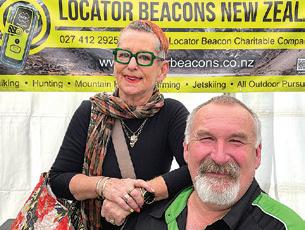
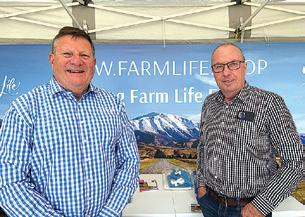


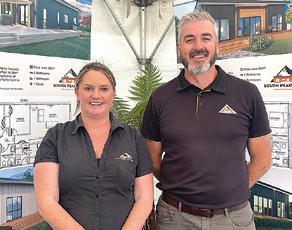

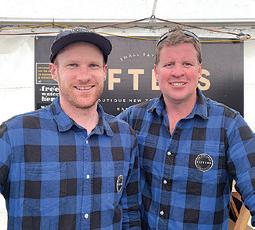

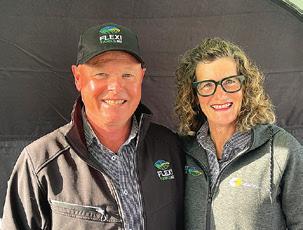






NewsFarming TOP SOUTH MONTHLY November 2022 31 SUPPLY POINT WORKING WITH YOU THE FARMERS FRIEND Always, FAIR PRICES, GREAT SERVICE, FAST FREIGHT Email: online@supplypoint.co.nz 10 Henley Street, Westport. Phone 0508 348 846 Mon-Fri 7:00am - 5:00pm | Sat-Sun: Closed www.supplypoint.co.nz Our Aim is to supply proven, quality products with prompt delivery to make it easy for you and your project. We work with many Engineering, Farming, Trade and Contracting Clients around NZ and look forward to continuing this trust through 2022. Check out our huge range of products from Culverts and Water tanks, to PVC Fittings, Poly Pipe fittings to Valves and Repair Couplings., PTO shafts and Bearings to Link Pins, Top Links and a huge range of hardware and accessories. Plus much more at fair prices and quick efficient freight. The website is designed to make it easy for you to select the right products, find a solution for your requirements and to make further ongoing transactions easy with smooth ordering and invoice processing. Order online, pop in or phone us. - offering further discount to assist with
damage
FLOOD REPAIRS
AgFest was held
in
Greymouth
on 14-15
October. The purpose of the event
was to give people in the rural
sector
the opportunity to showcase their business, to celebrate the agricultural industry and its significance to all businesses on and around the Coast.
Warren Williams and John McIntyre
Alex Lond and Sarah Morgan
Anton Meier and Jacky Van Der Poel
Debbie and Phillip Russ
Hamish Bourke and Stuart Clark
Kyllee and Paul Henton
Michelle Rodley and Shannon Carlson
Nicky Schultz and John Munro
Peter Thompson, Terry Gee and Neil Bradley
Phil Paul, Carol Keoghan and Alastair McNeill
local forestryupdate
The men behind the changing logging industry
All around New Zealand and the top of the South Island there are large forests continually being harvested in rotation. The indus try brings income to our region and provides jobs for skilled local people. Forestry is now also the second biggest earner of overseas funds over-taking tourism since Covid. A considerable volume of timber is now used at local mills with a future focus of adding val ue. A large percent of logs does not meet NZ building standards, therefore it’s exported. Trials are currently underway to utilise for estry slash, mulch it and send it to overseas markets as a source of bio-fuel. Forestry often gets bad press because of a bygone era when operators were less aware of environmental impacts and the death rate was unacceptably high. Modern logging gangs are made up of highly skilled operators, many of them balding or with grey hairs, who learned from the mistakes of earlier times and who are committed to changing how the industry functions in a changing modern world. Radiata pine forests sequester carbon and practices are continually improv
ing. Harvesting is mechanised ,making the whole industry much safer.
Under the Pump
Bevin Friend started work in sil viculture straight out of school as a sixteen-year-old over forty years ago. Eventually after a cou ple of years he moved into forest ry, logging and truck driving. He enjoys his current role with En durance Logging as loader opera tor, driving big machines, sorting logs into their size categories and loading trucks. “You are under the pump,” he says. To the unini tiated this sounds simple but it’s a key role, keeping logs moving re quires awareness of what’s going on around the skid site, commu nication, and concentration, plus a mechanical/technical aptitude. He says for anyone looking to get into forestry work, it means ear ly morning starts and long travel distances. Operators need to be
reliable, hard-working and above all, safety conscious.
Making a mess tidy again
Canadian born Lorne Wells is the offspring of Westcoast, Kiwi par ents who lived in Canada for a few years. The whole fam ily returned to New Zea land in 1994. Lorne says, he loves his job for the variety and how with his
tisingpr oof
ward.” Leith Cotton works in his family transporting company, shifting heavy forestry machin ery. In fact, he says, they will shift anything from houses to boats ,from Kaitaia to Bluff all around the country. Mostly he trans ports heavy duty diggers, haul ers, and bulldozers from site to site around the top of the South Island. Leith says, “If you can’t back a machine, you shouldn’t be allowed to drive it forward.”
QUART VE
12.3X12.4, cms width by
9/06/2021 12:22:08 PM
tisingpr oof
One of his more interesting jobs involved bringing a train engine and two carriages over the Pelo rus Bridge for some collectors at Belgrove, and recently he took one down to Christchurch. The jobs are a constant challenge, es pecially when working around cities where there is a time curfew to avoid peak hours which means he is constantly racing against the clock. “Without the challenge,” he smiles, “I’d be bored.”
QUART VE
by
9/06/2021 12:22:08 PM
big digger he can turn a chaot ic mess into something tidy and working again. Lifting large cul verts into place and placing rocks to withstand storm water run-off, or maintaining forestry road ing, the job is always different. Currently working for Berkett’s Contractors sorting out storm damage, Lorne says he loves his chosen career.
Transporting truckie
“If you can’t back the vehicle you shouldn’t be allowed to drive for
Tight corners and nervous moments
Rick Hooper started his forestry career in silviculture, straight out of school. He was one of those youngsters who thrives when
there’s work to be done. Then he moved to break-out work on harvesting sites, attaching ca bles to felled trees so they could be hauled up to the landing site. When he first started this was one of the most physically demand ing jobs in forestry. He laughs, and says now everything is me chanically harvested and we sit in big machines, getting bigger ourselves. But forestry is a safer business now. Managing people and the operations on site can be stressful at times but mostly he enjoys the role. On his latest job, negotiating large machines down a narrow road and over bridges, he had a few nervous moments. As foreman for Endurance Log ging, he’s managed quite a few shifts. Rick says, with attention to detail and pre-planning we always get there, but I’m always nervous until the jobs done!
25 years experience in the industry the Tasman Forest Management (TFM) team
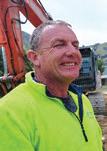


services in:
• Forest and woodlot harvesting
• Domestic and Export Log Purchase
• Forest Establishment
• Emissions Trading Scheme

• Forest Valuation
• TFM are part of the Forest Management Group with offices throughout the South Island, Hawkes Bay




Southern North Island

adver
Please check your proof carefully and approve it or submit corrections by the Final Proof Alterations deadline. now appro ve or submit changes to your ad within the ATOL system at a time that suits you. Just follow the link proof email to view your ad, then cl ick the APPROVE or CORRECTIONS button right from there no new emails required! The Professional Forest Management Company of Choice. PF Olsen is the leading provider of independent professional forestry services in New Zealand. Contact us now for all your forest management needs: • Harvest management and log marketing • Forest establishment and tending • Forest valuations • Due diligence on forest purchases/sales CH-8994297AA Nelson 03 544 0066 Blenheim 03 577 6675 OLSEN & CO LTD (RMD) publishing 06/24/21 booked size CSQ
CH-8994297AA (100%) publication Adv Supp NEM dimensions 12.3X12.4, cms width
height section CUSTOM SQUARE proofed
adver
Please check your proof carefully and or submit corrections Final Proof Alterations deadline. ve or submit changes to your ad within system at a time you. Just follow the link view your ad, then cl ick the APPROVE CORRECTIONS button right there - no new emails required! The Professional Forest Management Company of Choice. PF Olsen is the leading provider of independent professional forestry services in New Zealand. Contact us now for all your forest management needs: • Harvest management and log marketing • Forest establishment and tending • Forest valuations • Due diligence on forest purchases/sales Nelson 03 544 0066 Blenheim 03 577 6675 LTD (RMD) publishing 06/24/21 size CSQ
(100%) publication Adv Supp NEM dimensions
height section CUSTOM SQUARE proofed
The Professional Forest Management Company of choice PF Olsen is the leading provider of independent professional forestry services in New Zealand. Contact us now for all your forest management needs: • Carbon accounting and advice • Harvest management and log marketing • Forest establishment and tending • Forest valuations • Due diligence on forest purchases/sales With
offer
advise and management
and
To find out more www.forestmanagement.co.nz Email: office@tasmanforest.co.nz Nelson 03 540 3177 Blenheim 03 572 7902 32 November 2022 Forestry Farming TOP SOUTH MONTHLY
livestock
Government rules out delaying winter grazing regulations

The government has refused to put a hold on winter grazing rules despite failing to implement crucial elements which will likely lead many farmers down an ex pensive consent process.
The current rules require farmers who graze livestock on an annual forage crop over winter, and do not meet a range of permitted ac tivity criteria, to either gain a cer tified Freshwater Farm Plan, or to apply for a resource consent from 1 November 2022.
Beef + Lamb New Zealand (B+L NZ), DairyNZ and Federated Farmers wrote to Minister David Parker in August calling for win ter grazing rules to be deferred until November 2023. After re ceiving no response, a second

letter was sent on 22 September, which was also copied to Prime Minister Jacinda Ardern.
On 6 October, the partner organ isations received a response from Minister Parker, which said the winter grazing regulations would not be deferred or amended.
“It is highly disappointing that Minister Parker has not listened to the sector and is pushing on with these unworkable regula tions, despite Freshwater Farm Plans not being available,” says B+LNZ chief executive Sam McIvor.

“We are currently working through the content of the letter with our partner organisations before determining any further action.”
Wide selection of breed types on offer
Merino and halfbred wool clips representing Marl borough, Canterbury and Otago growers continued to feature at wool auc tions held in Christchurch during September and Oc tober.
Coarse wool growers were also very well represented, mainly by hogget wools but also via some very stylish pre-lamb shorn ewe clips. The respected adage, “there is no substitute for quali ty”, rang true as wool ex porters showed a keenness to bid strongly for super style wools across the breed spectrum, whilst poorer types were discounted ac cordingly.
As crossbred shorn hog get types began to domi nate coarse wool offerings during October, prices fluctuated somewhat with only very good wools gain ing maximum attention. Vegetable matter contam ination (vm), colour, and staple length obviously re mained key in determining
price, but with many wools coming from wetter areas and showing light mud on the staple tips, yields were in some cases affected neg atively which had a bearing on buyer demand due to an expectation that actual scoured yields would also be lower than desired.
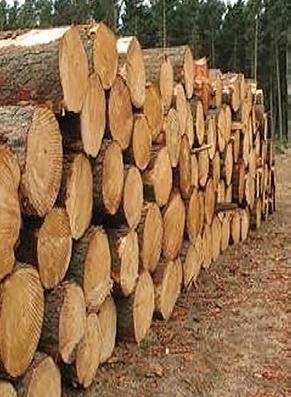
Full length fleece of super style (very good colour, sound tensile strength and no vm), was embraced by the trade with prices around the 400 cents per clean kilogram mark.
Crossbred second-shear struggled to maintain their earlier levels with shorter second-shear most affect ed.
A very good selection of halfbred and corriedale wools were catalogued during October with many measuring finer than about 28 microns, improving considerably on 13th Oc tober auction, compared to earlier.
A number of lines which had been passed-in during the September auctions, bounced back significantly on 13th October with sev eral recording increases of more than 100 cents per ki
logram greasy. Halfbred and corriedale oddments also improved during October, albeit from a low base.
With good quantities of well-grown merino wools catalogued for both the 29th September and Octo ber 13th South Island wool auctions, buyer interest was considerable, despite that, in between the two NZ auctions, Australian bro kers had reported a distinct softening in market inter est.
The September 29th Christ church auction saw pric es for most merino wools reach well above those ruling across the ditch the same week.
However, October 13th proved a little harder go ing in Christchurch as wool quality, in general terms, although still very good, may not have been of such a good standard as the pre vious sale with the most emphasis on slightly poor er Length & Strength test data.
Buyers attending the Christchurch auctions rep resented mainly European manufacturers, who have

always been keen to buy good quality merino types from the South Island, whereas Australian broker wool auctions are mainly dominated by wider Chi nese buying interests.
During the next few weeks, the fine wool selling sea son will wind down sub stantially as most stations complete their hogget and wether shearing, resulting in a swing towards larger numbers of coarse wool sheep being shorn from November on.
With prices for coarse wool having remained low for such a long time, plus shearing and freight costs having increased substantially, reports indi cate that there is likely to be more full-length fleece wool available towards the summer months than sec ond-shear types, due to that practice having been overlooked by some grow ers in order to save costs. Therefore it will be interest ing to see how some of the longer coarse wools have fared through the rather challenging spring weather patterns experienced. That’s my view.
D Stuart Forestry Ltd Independent Log Buyers Forest Managers Harvesting Marketing & Establishment Ph 03 542 3769 Mob 021 223 1099 stuartforestry@outlook.co.nz LivestockFarming TOP SOUTH MONTHLY November 2022 33
Chairman of Beef + Lamb NZ, Andrew Morrison and CEO, Sam McIvor.
Photo: Supplied.
Got something to buy, sell or promote? Contact us: sales@nmf.co.nz Farming TOP SOUTH MONTHLY
fertilizer When local is best
Some years back there was a government backed campaign to buy locally made merchan dise. How effective it was is un known, however there was no way I was going to part with my hard-earned dollars for a New Zealand product unless it was as good as and price competitive with an imported one.
Since then the world has em braced globalisation and the price of products imported from countries with lower labour costs has largely dealt to prod ucts from our traditional sup pliers.
When price becomes the sole, or main, determinant of purchas ing decisions quality deterio rates and value, what we get for our dollar, becomes increasingly difficult to ascertain.
As the pressure for immediate gratification has strengthened, successful farming, always a long-term venture, has suffered as the industry has embraced short-term band aids for sys tems that have become increas ingly wobbly.

With fewer multi-generational farming operations some really useful stuff is in danger of being lost. Which doesn’t mean every thing of yesteryear was better than that of today, that’s sim ply not the case. Animal health remedies, often dismissed as old
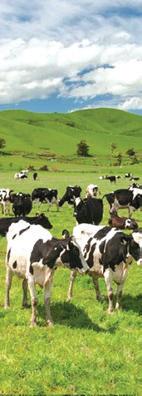
wives tales, nearly always con tain an element of truth and one piece of advice I received was that Golden Bay dolomite applied annually was a must-do. No more cows down behind hedges at five in the morning was the message given then and the feedback from farmers now. There is only one dolomite mine in the country and that is at Golden Bay, which means trans port to property is a factor. How ever, it’s a lot less than cartage from the other side of the world which is hidden in the price paid for magnesium oxide. Continu ity of supply is also guaranteed, which is not the case for import ed products.
The timing of application is rel atively unimportant. Provided dolomite is applied at twelvemonth intervals the lift in plant magnesium levels remains con stant.
Another reason for it being the most effective magnesium fertiliser is the fact that it also contains calcium. Magnesium related metabolic disorders are seldom due to just a lack of mag nesium, it’s the balance between the two that is critical.
Prior to calving animals require extra magnesium to help release calcium from the frame, post calving extra calcium is required to meet lactation demands and dolomite delivers both.
Long-term dolomite users will sometimes also make a bin of dolomite available along with one of lime flour and allow an imals to choose. It’s a highly effective way of ensuring opti
mum calcium and magnesium levels throughout the year, and it doesn’t much matter if they get wet.
And the upside doesn’t stop there. Dolomite is an excellent soil conditioner in its own right and applied at the standard 200 - 250kg/ha rate to soils damaged during winter it helps with re covery.

Soil is ideally 25% air and 25% moisture, and the conditioning effect of dolomite helps achieve that status. It also has a pH or liming effect similar to high quality ag.lime. Four years of applying dolomite at 250kg/ha, the highest rate required for pas ture, means 1.0 tonne less lime will be necessary to maintain optimum soil pH.
The cost of the annual appli cation can be further offset by reducing the amount of magne sium in water supplies. All an imals perform best when their drinking water is clean and fresh. The addition of magnesium sul phate and chloride makes water unpalatable resulting in animals drinking from puddles largely negating the intended effect.
A single annual application of Golden Bay dolomite is a stress-reliever for operators and a production enhancer for an imals. As the late Prof Walker of Lincoln University wrote, “… individual farmers will have to make their own calculations, but in my view dolomite is the ideal material to use on acid soils low in magnesium...”
For more information call Peter on 0800 436 566.
Farming for our future
JOHN BARNES Managing Director Fertilizer New Zealand


What is farming going to look like a few years from now? This is something we all want to know.
One thing is for cer tain, there will be change. Fertilizer New Zealand invests in research. We want to be part of this work because think ing differently and looking for sustain able farming practic es is the basis of our Company.
We are investing in the research for building future Agro-ecosys tems that lead on to future Food scapes for Health so that we will have a healthier planet and food that creates health and wellness.
We believe in restoring soil health, and creating healthier pasture for our animals which leads on to our own health.

Feeding the soil that feeds us is the start of the process of the food chain, so it stands to reason that if the soil is not fed properly
then what we eat will be inferior. Every day, mostly three times per day, we rely on the soil to produce what we eat. We apply poison to kill the pests and the diseases in our crops or in our animals and then we consume them. It is quite pos sible that some of these chemicals will end up in our food. However, regener ative farmers are aware of these issues and have worked to correct them. At Fer tilizer New Zealand we do this through adding microbiology to our nutrient farm plans. Our research shows an improved soil holding capacity, greater nutri ent retention, reduction in grass grub and disease and reduced fertiliser input. This is a win-win for the farmer and consumer.
It all starts in the soil - a healthy soil will encourage a healthy plant, superior taste and is in credibly healthy. This leads to healthier people.
For farm plan enquiries please phone 0800 337 869 or visit www.fertnz.co.nz

34 November 2022 Fertilizer Farming TOP SOUTH MONTHLY
Got something to buy, sell or promote? Contact us: sales@ nmf.co.nz Farming MONTHLY
horticulture
Women leadership trio help Summerfruit sector prosper
People, diversity and the oppor tunity to help those in the indus try are among the aspects of their work that Kate Hellstrom, An drea Crawford and Tracey Man sfield of Summerfruit NZ most enjoy.
The trio, all members of Women in Horticulture, acknowledge the past two years have been partic ularly hard for growers, but that has fuelled their passion to do all they can to assist growers to get through.

Kate is chief executive of Sum merfruit NZ, Andrea is busi ness manager and Tracey, labour co-ordinator. Together, with technical advisor Richard Mills, they make up Summerfruit NZ’s management team.
“The horticulture industry has remained in a constant state of flux due to ongoing and complex challenges,” she says. “The global pandemic, we are experiencing a severe labour crisis and very high turnover rates. Global supply chains remain heavily disrupted and weather events have contin ued to impact on all our growing regions.”
Kate says leading Summerfruit NZ through its own down-sizing changes and during uncertain times has been a positive person al challenge.
“Our board members are very
supportive and generous in shar ing their knowledge of the indus try and the unique skills and ex perience they each bring to their role. A big thanks to the team and the board for their invaluable contribution to our sector.”
Summerfruit NZ’s business man ager, Andrea, also grew up in Wellington and has a Bachelor of Commerce and Administration and a major in Marketing and Management from Victoria Uni versity.
Andrea joined Summerfruit NZ on contract in 2018 and became a permanent employee in 2019.
Andrea got into the horticulture sector in 2009 by accident when
she became a part-time database administrator for HortNZ.
“I was looking for a complete change and soon got hooked,” she says. “I then moved into roles in HortNZ and vegetable product groups along with [a role] at the Primary ITO before moving to Summerfruit NZ.”
“I provide support to the chief executive and the rest of the team in governance, back-office man agement, IT support, and tend to be involved in engagement with a variety of stakeholders. My role is facilitating support for the other team members and their respec tive portfolios.”
And it’s a role she loves. Howev
er, it’s not always easy.
“The business environment is changing so fast these days,” An drea says.

“We have to adapt our business models and develop new ways to meet these challenges, or we sim ply won’t survive.”
Summerfruit’s labour co-ordi nator, Tracey, who now lives in Arrowtown, grew up in rural Southland, in Otautau. She has a Bachelor of Physical Education and a Bachelor of Arts in Geogra phy, with a Post Graduate Diplo ma in Secondary Education from Otago University.
Tracey’s role at Summerfruit NZ, which also includes some com
munication work and events co-ordination, was created in No vember 2020 in response to the labour crisis caused by the im pacts of the Covid-19 pandemic.
“Raising the profile of seasonal work to students, backpackers, grey nomads, or anyone of work ing age, is what I do,” she says.
“The role also includes keeping up-to-date with changing immi gration rules and Covid-19 pro tocols, and building relationships with growers and a large number of stakeholders.”
Tracey says the sector is not with out its challenges, though.
“It is also not nice hearing from growers who are doing it tough, season after season.

Despite the tough times over the past few years, Kate, Andrea and Tracey strongly recommend hor ticulture as a career for women to pursue.
“It’s a great industry with a lot of variety,” Tracey says. “There are amazing opportunities for women, on orchard or within the wider industry. It’s fun, challeng ing, and always changing, which makes it interesting.”
To keep up-to-date with Women in Horticulture, its news and ac tivities and to join the membership database, email:info@women-inhort.nz. All are welcome.
One team and keeping everyone happy
NADINE TUNLEY HortNZ
The recent welcome announce ment by the government that the Recognised Seasonal Employer (RSE) cap for 2022-2023 would increase to 19,000 came after weeks of discussions where it be came obvious that there are dif fering needs for horticulture.
Within the sector we know this, but the government, at a number of levels, does not understand. Yes, I hear you say, “well they should” and I used to think that as well. However, I have learnt that with finite resources and more often than not, tight to un realistic time frames, we need to choose our battles.
The government expects the horticulture sector to come to it with one point of view. It does not have the time or inclination to deal with us all separately. This situation means that between us, we often need to quickly come to a shared position and communi cate that succinctly and clearly to the government, as the final deci sion-maker.
Early next year, a substantive re view of the RSE scheme will get underway. In this review, it will be imperative that we come to gether as effectively and efficient ly as possible to articulate grow ers’ views and be united. If we can’t do this, we risk losing our seat at the table.
I often hear growers say that
HortNZ should ‘just walk away’ from the government’s negotia tion table. To me, that is not an option. We must main tain our position so as to be able to put for ward our view. Note I said view and not views. The reality is you all have different views be cause you are looking at things from your part of the sector’s perspective. That is what we, as your representa tives, would expect. However, my team’s and my role is to collate and distil all these different views, and present the best collective position. HortNZ can only do this if we are trusted and have a thorough un
derstanding of the dynamics and challenges of commercial fruit and vegetable growing in New Zealand. To be confi dent in our views, we need growers to talk to us, their product groups and district associa tions, who then need to work with us to form a collective response. This will definitely need to happen in the review of the RSE scheme next year. The gov ernment is counting on there be ing one team at the negotiating table (which includes viticulture for this topic).
If we don’t come together as one team, we will be unable to ensure that the RSE scheme continues to
enjoy the success that it has over the past 15 years.
The other point I would like to make is being able to come to a collective view quickly is the best use of grower levy money. They say that talk is cheap but I can as sure you it is not. Talk costs and it could cost our industry dearly, in the context of future central gov ernment policy decisions. That’s been the reality of the RSE cap increase decision. Leave mil lions of dollars of fruit on the trees and vegetables in the field, and reduce the value of the New Zealand brand in overseas mar kets through quality issues – or find a compromise position: one that our entire industry can make work.
HorticultureFarming TOP SOUTH MONTHLY November 2022 35
Andrea Crawford, Kate Hellstrom and Tracey Mansfield. Photo: Supplied.
motoring
The last of a wonderful era
Country MOTORING with Ken Strungnell



The last magic 4.5 litre turbo die sel model from Toyota is almost gone. The V8 70 series Land cruiser truck left me loving it and lamenting its passing.
Over the years, since the late 70’s, I’ve enjoyed driving, first the 4.2 litre petrol 6 and in recent times the 151kW 430Nm V8 Land cruiser truck.
Long before the Hilux made its appearance the Landcruiser along with Corolla Corona and Crown and flew the flag for Toy ota, cementing Toyota’s place in New Zealand.

To the not inconsiderable $85,390 dealer sticker must be added a tray of around $7,000 plus Ja cinda tax $5,175, taking the base price to just shy of $100k. That hasn’t put off many buyers as orders for 2022 and 23 are now closed. Interestingly, I had the only FENZ Landcruiser on our farm concurrently. Fundraised by the Diamond Harbour residents the volunteers are thrilled with the vehicle.

As you’ll see from the photos it has been repainted in red and has some non standard options such as a 75mm lift and heavy duty shocks as well as the En glish-made tray/box that holds equipment for rescue, fires and searching. I n addition it’s fitted with comms and lights siren and horn. I was
cheeky enough to ask what it cost. Hmmm.... well you could buy TWO top spec Hiluxes, was the eventual reply.
My white LX Double Cab looked small by comparison. The 4 door Cruiser has a 5 speed manual with long shift throws emphasis ing its rugged truck like demea nour.
Now fitted with auto front hubs front and rear locking diffs, ac tive traction control and hill start assist, as well as the ABS and ve hicle stability control, allows for extreme off-road prowess. Seating for five is generous in the
front though somewhat less so, for the rear pews, which are bet ter suited for two.
Still, it has two IsoFix points, a 12 volt socket, storage behind the seat back and door pockets, so there’s that. Access to the 70
is from a heavy duty pair of side steps.


The interior is well appointed with hard wearing cloth seats, a 6.1 inch infotainment screen with rear camera, sat-nav and a basic cruise computer.
Included though is SUNA traffic control [where available] Blue tooth for streaming and phone, which was super clear and easy to use. Also two USB charging points.
Driving the 70 on road is easy and relaxed. The torque produced at 1200rpm allows progress even in fifth which while muting that delightful song of the diesel V8 allows for fewer gear changes. Disc brakes all round pull up the 70 quickly and without fuss.
Body-roll is very evident when pushed quickly through corners or on uneven surfaces, yet it’s well insulated from road noise.




At a quoted 12l/100km will trav el 1080km, from the 130l diesel tank

By far the most impressive feature is the off-road prowess, where most 70’s will live. Like most utes it tows the same 3500kg braked, can wade 700mm in standard trim though the snorkle adds to level sustantially depending on water-flow rate.


It climbs, descends and attacks slopes, inspiring confidence thanks to the mud and snow
285/70/16 tyres.
It’s extremely unlikely an EV ver sion of the 70 will ever emerge, so for now I expect this tio be the last of a wonderful era.
36 November 2022 Motoring Farming TOP SOUTH MONTHLY
Hilux is dwarfed by the Land Cruiser 70 fire truck and the long box on the rear of the FENZ 70 accentuates the size of the vehicle. Photos: Supplied.
General Earthworks House Sites Driveways Diggers Tip Trucks Loaders Rollers Land Clearing & Development Roading & Drainage Tama 0276 085 144 sollytama@gmail.com

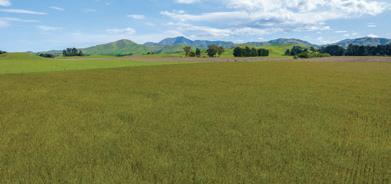



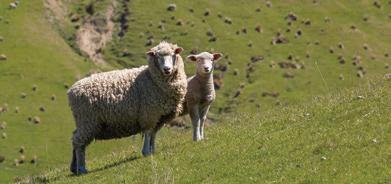
Accelerating success. colliers.co.nz Versatile Finishing/Cropping with Upside For Sale by Deadline Sale closing Wednesday 30 November 2022 at 2pm (unless sold prior) Located at Ward, 45km from Blenheim via State Highway 1 • 184ha held in six titles and surrounding the Ward township • Flat to gentle contour with approx 95% workable • Currently utilised as a support/finishing block for an adjoining breeding property • Approx 775mm average rainfall, loam soils, three bedroom dwelling • Subdivided into 21 paddocks, reticulated water from the community water scheme • An adjoining 494ha breeding unit can be purchased in conjunction or separately Marlborough Rural Realty Limited T/A Colliers. Licensed REAA 2008 For Sale colliers.co.nz/p-NZL67021113 Andy Poswillo 027 420 4202 andy.poswillo@colliers.comState Highway 1, Ward, Marlborough “Brackendale” 494ha For Sale by Deadline Sale closing Wednesday 30 November 2022 at 2pm (unless sold prior) Marlborough Rural Realty Limited T/A Colliers. Licensed REAA 2008colliers.co.nz/p-NZL67021153 Andy Poswillo 027 420 4202 andy.poswillo@colliers.com251 Gulch Road, Ward, Marlborough • Located in the vibrant rural community of Ward, 45km south of Blenheim via State Highway 1 • A seldom available opportunity to purchase a Marlborough sheep and beef property running Corriedale X ewes and Angus cows • Four bedroom homestead (renovated in 2000) with in-ground swimming pool. Numerous sheds and outbuildings including three stand RB wool shed (800 NP), cattle yards and sheep yards • Minimal weeds, inherently sweet country with good balance of flats, easy to medium hill country. Historical 800mm rainfall • A 184ha adjoining finishing property is also available to purchase For Sale AdvertFarming TOP SOUTH MONTHLY November 2022 37
Government response to He Waka Eke Noa for agricultural emissions
 SAM McIVOR CEO Beef+Lamb
SAM McIVOR CEO Beef+Lamb
The government released its re sponse to the He Waka Eke Noa Primary Sector Climate Action Partnership proposal on the pric ing of agricultural emissions.
While Beef + Lamb New Zealand would prefer farmers didn’t face a price for their emissions, the gov ernment has been very clear that pricing will begin by 2025 and it already has legislation in place. New Zealand is the first country in the world to look to put a price on agricultural emissions. While we recognise our role in reducing emissions, we are one of the most carbon efficient producers in the world and we will not accept a system that disproportionately puts our farmers and communi ties at risk.
As part of the proposal released today, agriculture will not be go ing into the Emissions Trading Scheme (ETS). Going into the ETS is something B+LNZ and other primary sector partners have been steadfastly opposed to.
The government has agreed to many of the He Waka Eke Noa proposals, but it has put forward some changes which we believe will impact sheep and beef farm ers and are not acceptable.
We need to fully analyse these changes carefully, and we will provide more information once we’ve done this, but one area of immediate and significant con cern is the proposed changes to sequestration, which we know is of real importance to many sheep and beef farmers.
B+LNZ and other partners are not happy with these changes and will push for better outcomes as part of the consultation.
We are also examining other ar eas that have been modified and
will be working through this process with our He Waka Eke Noa partners and seeking feed back from farmers. These areas include proposed changes to the emissions price setting process and criteria, and the linking of the nitrous oxide price to the ETS price.
The He Waka Eke Noa proposal was designed as a carefully bal anced package that was as equi table as possible across all parts of the sector. The modelling the government released today rein forces just how serious this is for our farmers particularly and how important it is that we get things right. It reinforces the need to take a cautious approach on any prices on agricultural emissions and also reinforces the need to adjust the methane targets.
Consultation on the govern ment’s proposals began (11 Octo ber) and ended on 18 November. It’s critical that you as farmers un derstand what’s being proposed
What has the government proposed?
A farm-level split gas levy. The government has agreed that the ETS is not an appropriate vehicle for reducing on-farm greenhouse gas emissions.
It has carried out modelling that shows only a modest price on methane is needed to achieve the government’s current methane reduction target for 2030, but its modelling does reinforce what we have been saying that any price on emissions will impact heavily on sheep and beef (and deer) farmers.
It has suggested a range of chang es to what the He Waka Eke Noa partnership proposed, includ ing to: sequestration; the pricing criteria and process; and linking the nitrous oxide price to the ETS
price. They did not make a de cision on the pricing details for fertiliser.
The government has reserved the right to start with a processor split gas levy for the first couple of years if progress on setting up the farm level system is too slow. The following is a preliminary analysis on some of the key areas and we will provide farmers with more detailed information in the next couple of weeks.
Sequestration
The most significant proposed changes are to sequestration.
The government has reduced the categories that farmers can get recognition for down to: indig enous vegetation where stock is excluded, which they could only receive additionality for, and ri parian strips.
Its ultimate objective is to add these categories to the ETS, but because this will take many years, they are proposing an interim separate contract-based system for the recognition of these cate gories.
We do not think these changes are acceptable. If farmers are to face a price on their emissions, they should get proper recogni tion for the sequestration hap pening on their farms.
Many farmers have found it diffi cult to get their post-1990 native trees into the ETS and our objec tive had been to set up something that was simpler, more practical and covered more categories of vegetation.
hard for changes to this part of the government’s proposal.
Price setting process and criteria
The He Waka Eke Noa partner ship had proposed that the agri cultural sector would have input into the advice to government on the setting of methane and ni trous oxide prices.
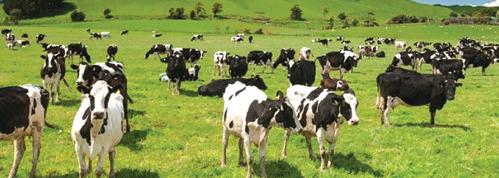
It had also proposed a range of criteria to reflect the price im pacts on viability, availability of emissions reductions technolo gies and equity across sectors.
The government has proposed that the Climate Change Com mission be responsible for rec ommending the methane price and that this advice is primarily based on progress towards the targets.
Socio-economic impacts would be considered as ‘secondary’ to meeting targets. We are con cerned this is too narrow a per spective on price setting.
The He Waka Eke Noa partner ship proposal reflected detailed analysis that showed price should not be the sole driver of action and that incentive payments to encourage the use of new tech nologies as they become available will have more of an impact.
Linking the nitrous oxide price to the carbon dioxide price
The partnership had proposed delinking the nitrous oxide price from the ETS-driven carbon di oxide price.
The partnership had recom mended a maximum starting methane price of 11c, and for the starting price to be held for three years.
While the government has not re sponded directly to this proposal, the government’s own modelling released with the consultation document makes it clear that lower prices than what the He Waka Eke Noa partnership mod elled could achieve the targets. This validates the modelling re leased by B+LNZ back in July and our ongoing position that we need to take a cautious approach to prices.
In particular, the government’s modelling indicates that a meth ane price of 8c per kilo by 2030 could achieve the government’s 2030 targets.
Note: B+LNZ does not agree with the current methane reduction targets and is working with other industry groups to get the targets adjusted.
The government’s modelling shows that the sheep and beef sector (and deer) are most heavily impacted by a price on emissions. This would likely be exacerbated by the proposed sequestration changes, reinforcing the impor tance of pushing for fair recogni tion of sequestration.
It also underlines the need to take into account a wider set of crite ria when determining prices.
Contracting
There is a lack of detail on se questration from the government (including what the sequestra tion rates could be) and we will be pressing them for additional information and clarity over the coming weeks. We will be work ing with other industry groups and talking with farmers over the coming weeks and will focus on pushing
However, the government has proposed linking the nitrous oxide price to the ETS (with a 95 percent free allocation that reduces by 1 percent a year) be cause it’s a long-lived gas and has a net zero target.
We need to study the long-term implications of this. An esca lating carbon price could have significant cost implications for farmers (including sheep and beef farmers).
The methane price and what the government’s modelling showed
There is some mention in the document about ways in which equity could be rebalanced, per haps through the incentive pay ments or some sort of levy relief but there are no details about how this could be done.
The lack of detail is concerning, and we will push for further clar ity.
We know there is a lot of con cern and confusion still out there around this process. We are in tending to host several face-toface meetings around the country over the coming month to share our views on the detail, get your feedback to inform our submis sion and also provide advice on making a submission.
Keep an eye out for information soon about a meeting near you.
• Round Bales (Fusion Baler) • Medium Square Bales • Wrapping • Fine Chop Silage • Mowing • Raking • 30 Cubic metre Loader Wagon • Drilling Brake
Noel and Jenny Brake 03 522 4557 A/H or 0274 539 517 Got something to buy, sell or promote? Contact us: sales@nmf.co.nz Farming TOP SOUTH MONTHLY 38 November 2022 News Farming TOP SOUTH MONTHLY
Looking for storage?















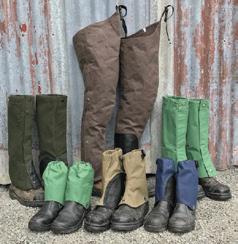




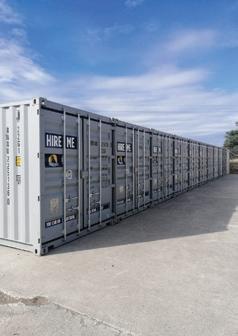
AVAILABLE NOW Give us a call on 03 577 9238 to find out more.
We have long and short term storage available for household item, boats, caravans, and trailers. Marlborough based. Export SEriES the indexed rotating clamping system 3 Angle adjustments • High Grade Stainless Steel • Hygienic • Easy Care • x2 clamps included, 1x Wide Clamp & 1x Narrow Clamp Visit scarysharp.co.nz for the full range talk to the manufacturer toll free 0800 175 720 The Constant Angle Knife Sharpening System The SIS Ball Cock Valve TARANAKI ENGINEERING SOLVING A NATION-WIDE FRUSTRATION WITH LEAKING BALLCOCKS So simple it could be serviced by your bank manager! Designed and manufactured We offer a lifetime warranty on the CNC machined main body 0800 175 720 www.sisballcock.co.nz We specialise in solutions for all budgets and needs. • Driveways • Patio’s & Paths • Decorative Concrete Cutting • Floor Placing & Finishing • Truck & Digger Services • Retaining Walls • Implement Sheds Call today for a free quote 541 8665 carterandsonsconcrete.co.nz Made in Canterbury New Zealand Puttees, Chaps, Radio Harness, Swag, Saddle Bags, and custom-made items www.mountainhighclothing.co.nz E: info@mountainhighclothing.co.nz P: 03 614 7731 www.stokegl.co.nz COMPOST PAVERS BARK SHINGLE GOATS WANTED DION BURGESS 022 199 7069 ALL BREEDS MALES / FEMALES / WETHERS FERAL GOATS DAIRY GOATS MEAT BREEDS ANY NUMBERS PROMPT PICK UP WILL BE ARRANGED SOUTH ISLAND ONLY dion@webuyanygoat.co.nz www.webuyanygoat.co.nz Save a Life this year - Your OWN! 406Mhz GPS digital www.locatorbeacons.co.nz Available for hire / sale from: Available in over 90 outlets. Available for sale/hire. $15 – 1 day | $30 – 3 days | $40 – 7 days $30 for every week after your first week of hire LED Head Lamps & Torches also available. SPECIAL Only $485 Includes FREE heavy duty pouch & delivery Are you working alone? What are your options in an emergency? Ph (03) 226 6341 or (027) 412 2925 locatorbeacons.co.nz NIKO TURIPA PH: 021 076 0388 E: niko@murchisonag.com MURCHISON REPAIRS & CONTRACTING AG • Servicing • General Engineering • 24 Hr Repairs & Maintenance • Farm Repairs • Welding / Grinding • Truck / Tractor Tyres • Effluent System Repairs • Heavy Equipment Repairs • Alloy & Stainless Work • Cow Shed & Yard Repairs • Machining LEWIS PASS / INANGAHUA / MURCHISON / LAKES NoticeboardFarming TOP SOUTH MONTHLY November 2022 39 Farmers Notice Board
















40 November 2022 Advert Farming TOP SOUTH MONTHLY YFZ50/YFM90 $9,300 ride away KLX 110/140 FARM & SPORT ANNESBROOK NELSON www.filco.co.nz TTR50 $2,699 incl From PW50 $2,399 $13,595 ride away HERE NOW! 700cc 2 seater BEAT THE PRICE RISE! LIMITED OFFER MULE PRO MX FILCO SOLUTIONS KFX90 AG125 $13,595 FILCO CALL US NOW! 03 547 2420 Rod Payne & Dave Filer If you need to upgrade your Yamaha workhorse it is vital you back order now Laybyfor Christmas Powerful 850cc, 4WD, larger tip deck, high profile suspension. Wolverine X2 Ute AVAILABLE NOW! BEAT THE PRICE RISE. KLR 650 ADVENTURE $3,299 incl IN STOCK AVAILABLE NOW $4895/$6095















 BARBARA STUART
BARBARA STUART
















 DARREN CRAWFORD
DARREN CRAWFORD













































































 JOE BLAKISTON
JOE BLAKISTON



































 Fertile Four Rivers Plains 24 Cole Rd, Murchison
Vaila Orchard Riwaka Tasman 85 Brooklyn Valley Rd, Brooklyn
For the first time if 150 plus years, this established family owned orchard with quality production history is offered to the open market.
Toby Randall
Fertile Four Rivers Plains 24 Cole Rd, Murchison
Vaila Orchard Riwaka Tasman 85 Brooklyn Valley Rd, Brooklyn
For the first time if 150 plus years, this established family owned orchard with quality production history is offered to the open market.
Toby Randall


















 GARRICK BATTEN
GARRICK BATTEN






 BARBARA STUART
BARBARA STUART

 DARYL CRIMP
DARYL CRIMP











































































 SAM McIVOR CEO Beef+Lamb
SAM McIVOR CEO Beef+Lamb

































